
Have you ever wondered about the wild world of creatures whose names begin with “Y”?
From the iconic Yellow Labrador Retriever that steals our hearts to the elusive Yellow-Lipped Sea Krait gliding through coral reefs, the “Y” family of animals packs a surprising variety.
These remarkable beings inhabit every corner of our planet—from the highest Himalayan plateaus, where Yaks roam, to the deepest ocean trenches, where Yellowfin Tuna slice through currents.
While not the most common letter in the animal kingdom, “Y” delivers extraordinary diversity in form, function, and habitat. Ready to meet these remarkable creatures?
Let’s jump into the unexpected and often overlooked world of animals that start with “Y.”
Popular Animals That Start With the Letter ‘Y’
1. Yellow-Throated Toucan
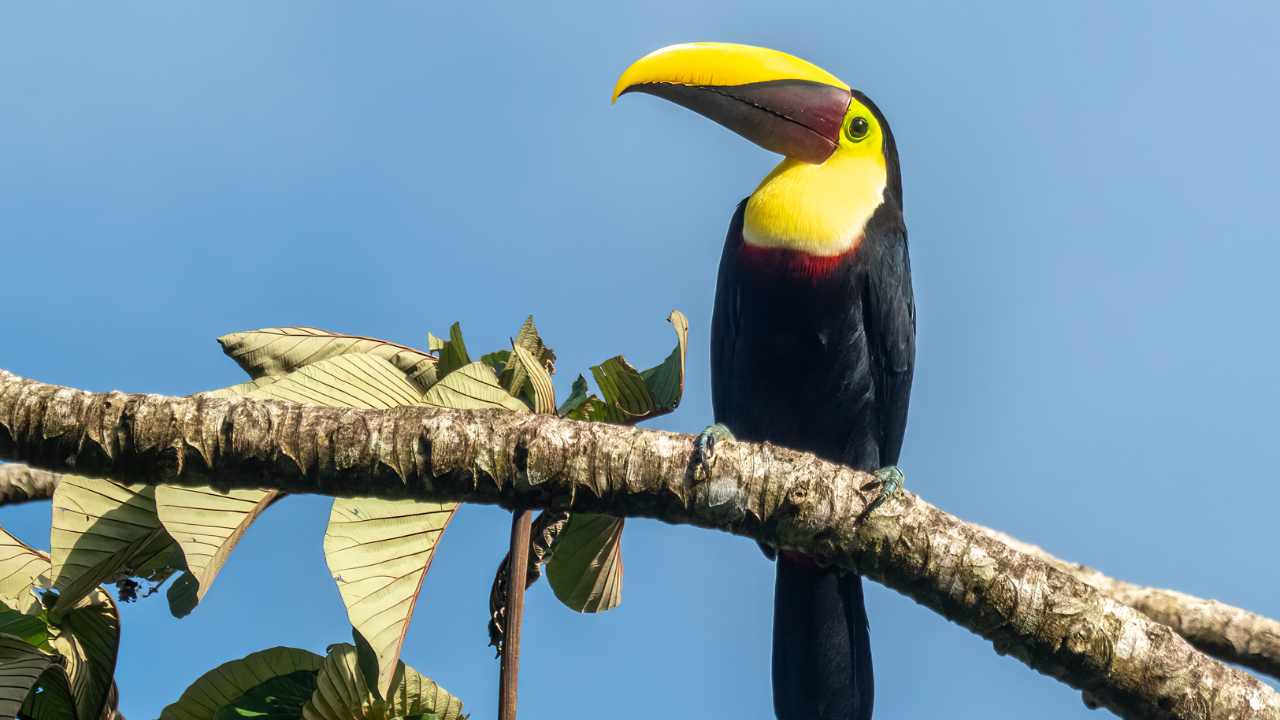
The Yellow-Throated Toucan has primarily black plumage with a white bib, yellow chest and throat, and an enormous, colorful bill that can be nearly as long as its body.
It possesses a lightweight, honeycomb-structured bill that appears massive but weighs very little, a long feather-like tongue, and zygodactyl feet (two toes forward, two backward) for perching securely on branches.
| Scientific Name | Ramphastos ambiguus |
| Origin | Central and South America |
| Habitat | Humid lowland and foothill forests from southern Mexico to northern South America |
| Fun Fact | Their seemingly awkward bills are actually highly sensitive and dexterous enough to pluck tiny berries. |
2. Yorkshire Terrier

The Yorkshire Terrier is a small dog with a distinctive floor-length, silky coat that is typically steel blue on the body and golden tan on the face, chest, and legs.
It has a compact body with an alert carriage, small V-shaped ears that stand erect, and a confident demeanor disproportionate to its tiny size.
| Scientific Name | Canis lupus familiaris |
| Origin | Yorkshire, England |
| Habitat | Domesticated; primarily kept as companion animals in human homes |
| Fun Fact | Despite their luxurious appearance today, Yorkies were originally bred as working dogs to catch rats in clothing mills during the Industrial Revolution. |
3. Yellowjacket
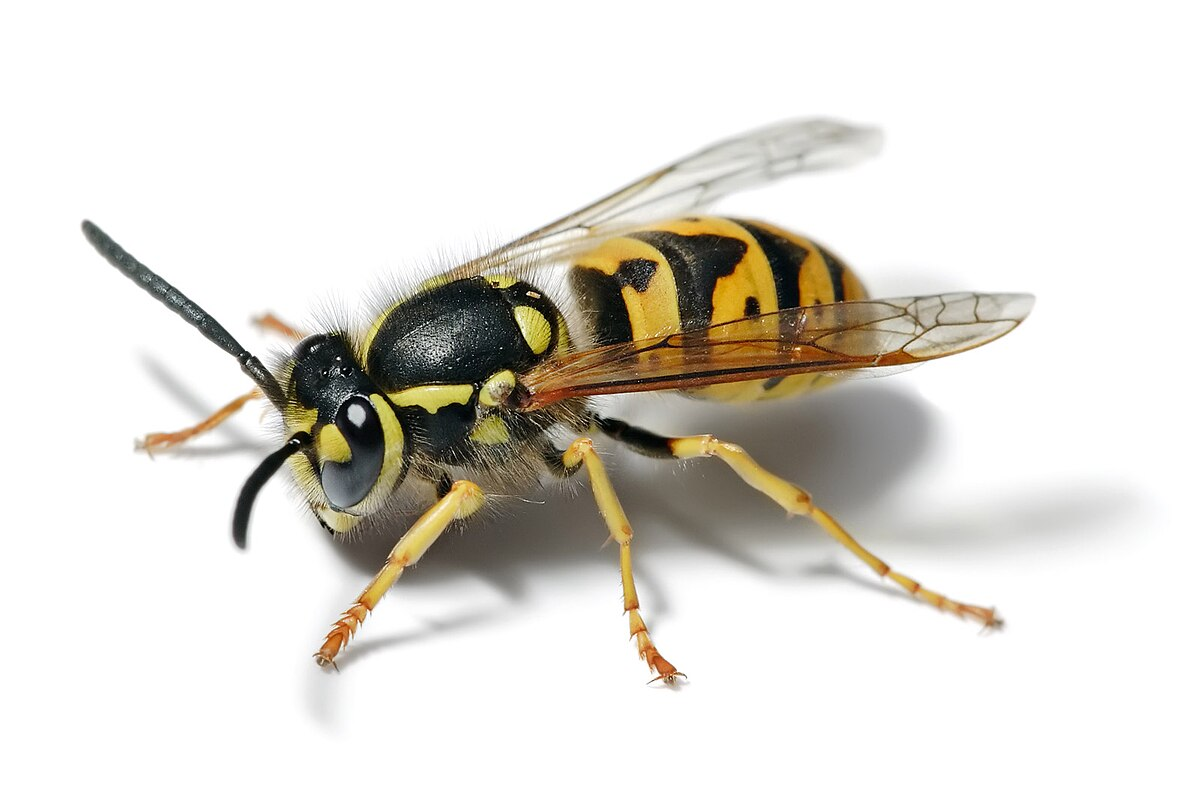
The Yellowjacket is a wasp with distinctive black and bright yellow striped markings on its abdomen and a slender “wasp waist” connecting its thorax and abdomen.
It has transparent wings, powerful mandibles for capturing prey and processing wood fibers for nest building, and a smooth stinger that can deliver multiple painful stings.
| Scientific Name | Vespula species |
| Origin | Northern Hemisphere |
| Habitat | Varies by species; typically builds paper nests in underground cavities, hollow trees, or building voids |
| Fun Fact | Unlike honeybees, yellowjackets can sting multiple times without dying and become increasingly aggressive in late summer and fall. |
4. Yak
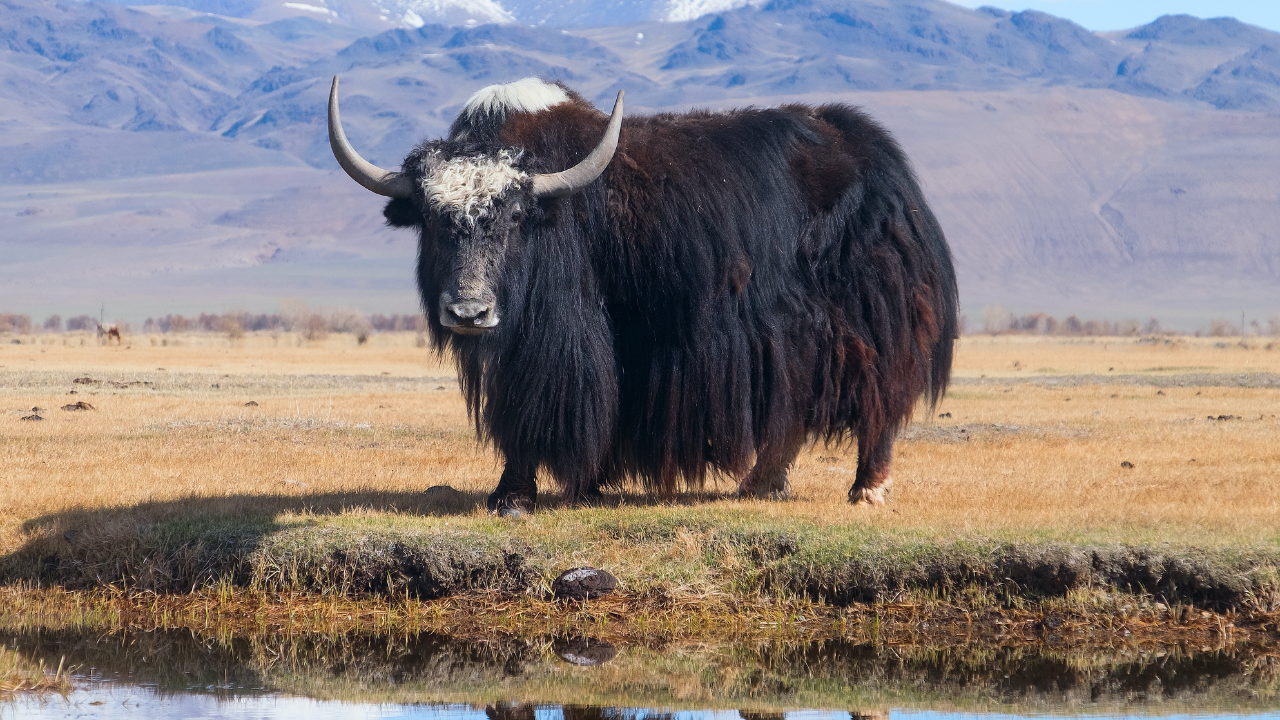
The Yak is a large, shaggy bovine with a sturdy build, humped shoulders, and a thick coat of long, woolly hair that hangs nearly to the ground, providing insulation in its high-altitude habitat.
It has distinctive curved horns, a broad forehead, and specialized cardiovascular adaptations that allow it to thrive in the thin air of mountain environments.
| Scientific Name | Bos grunniens |
| Origin | Tibetan Plateau, Central Asia |
| Habitat | High-altitude grasslands and plateaus of the Himalayas, Tibet, and surrounding regions |
| Fun Fact | Yaks have three times more red blood cells than lowland cattle, allowing them to efficiently absorb oxygen in high-altitude environments with thin air. |
5. Yellowfin Tuna
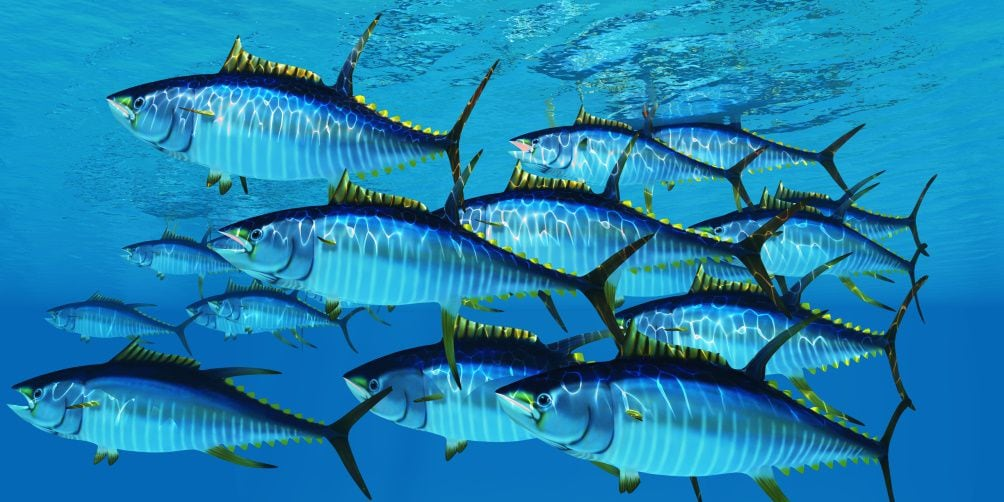
The Yellowfin Tuna is a large, streamlined fish with a torpedo-shaped body, metallic blue-black back, silver sides, and distinctive bright yellow dorsal and anal fins that give it its name.
It possesses a series of specialized finlets running between its main fins and tail, retractable pectoral fins that fold into slots for reduced drag, and a powerful crescent-shaped tail for propulsion.
| Scientific Name | Thunnus albacares |
| Origin | Tropical and subtropical oceans worldwide |
| Habitat | Open ocean waters, typically in the upper 100 meters of the water column |
| Fun Fact | These remarkable fish can accelerate faster than a Porsche and maintain speeds of over 40 mph during sustained swimming. |
6. Yellow Tang
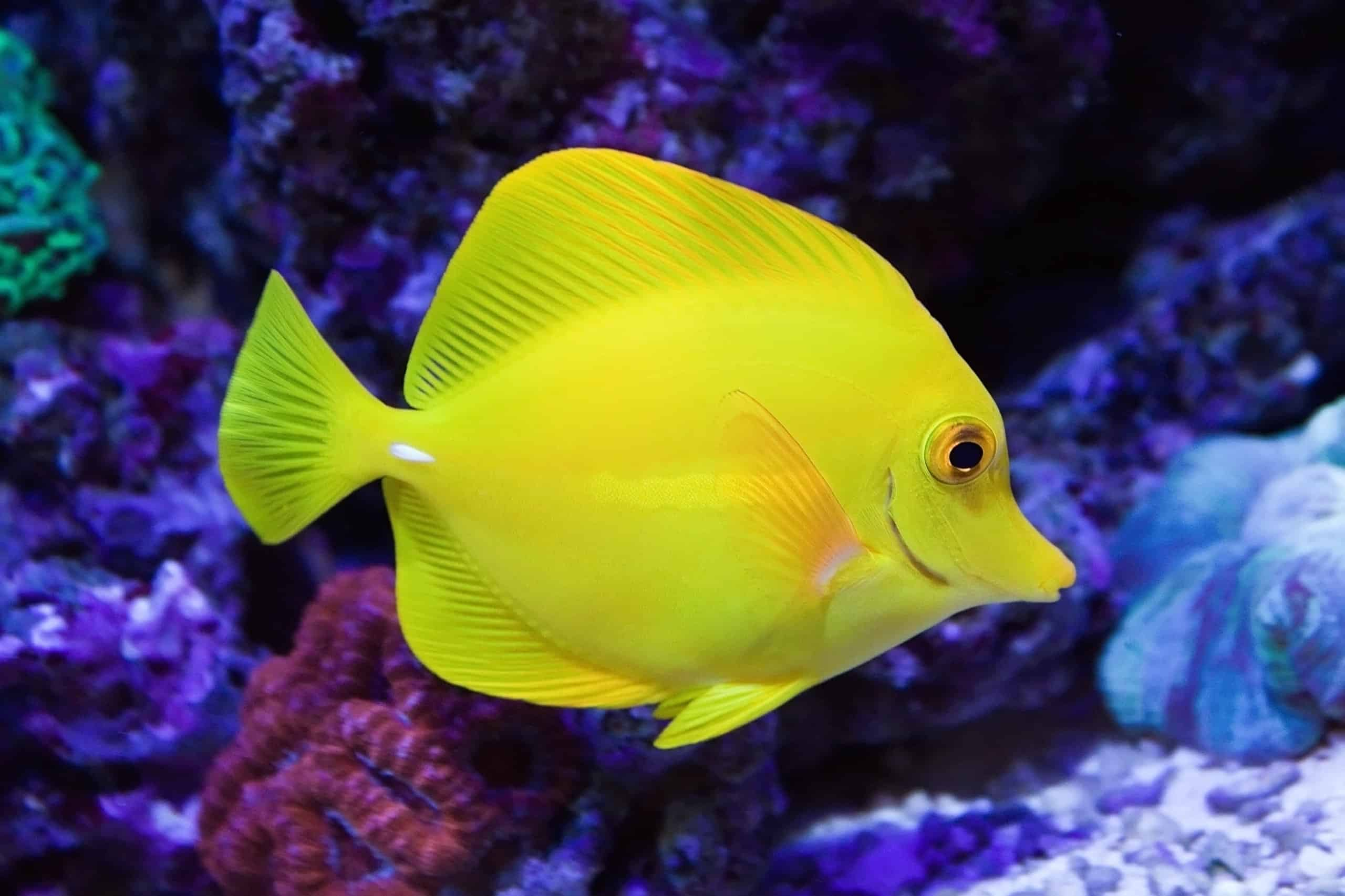
The Yellow Tang is a bright lemon-yellow reef fish with an oval, laterally compressed body and a distinctive scalpel-like spine at the base of its tail used for defense.
It has a small mouth with brush-like teeth perfect for scraping algae from coral and rocks, and can rapidly change its brilliant yellow coloration to a muted brown when threatened or sleeping.
| Scientific Name | Zebrasoma flavescens |
|---|---|
| Origin | Pacific Ocean |
| Habitat | Coral reefs around Hawaii and western Pacific islands |
| Fun Fact | These fish can live up to 30 years in the wild and form unique “cleaning stations” where they remove parasites from larger fish. |
7. Yellow-Rumped Warbler
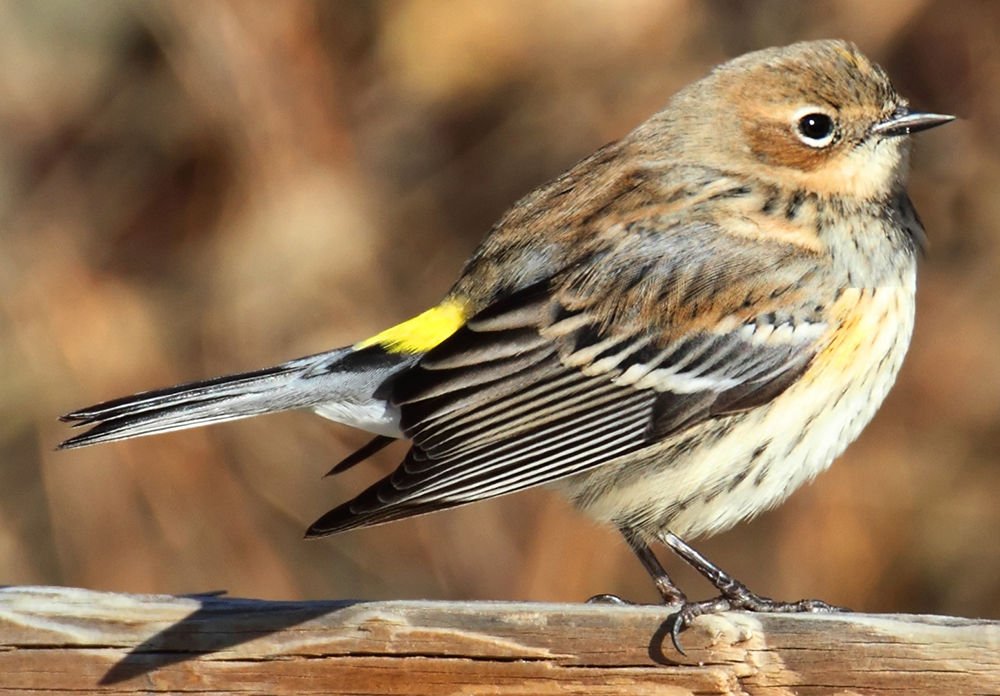
The Yellow-Rumped Warbler is a small songbird with a gray upper body, white throat, and distinctive yellow patches on its crown, flanks, and most notably, the rump.
It has a slender bill perfect for catching insects and a rapid, buoyant flight pattern that allows it to catch prey mid-air during its distinctive aerial feeding behavior.
| Scientific Name | Setophaga coronata |
|---|---|
| Origin | North America |
| Habitat | Coniferous and mixed forests during breeding season; various habitats including open woodlands during migration and winter |
| Fun Fact | Unlike most warblers, this adaptable bird can digest the waxes found in bayberries, allowing it to winter much farther north than other warbler species. |
8. Yellow Anaconda
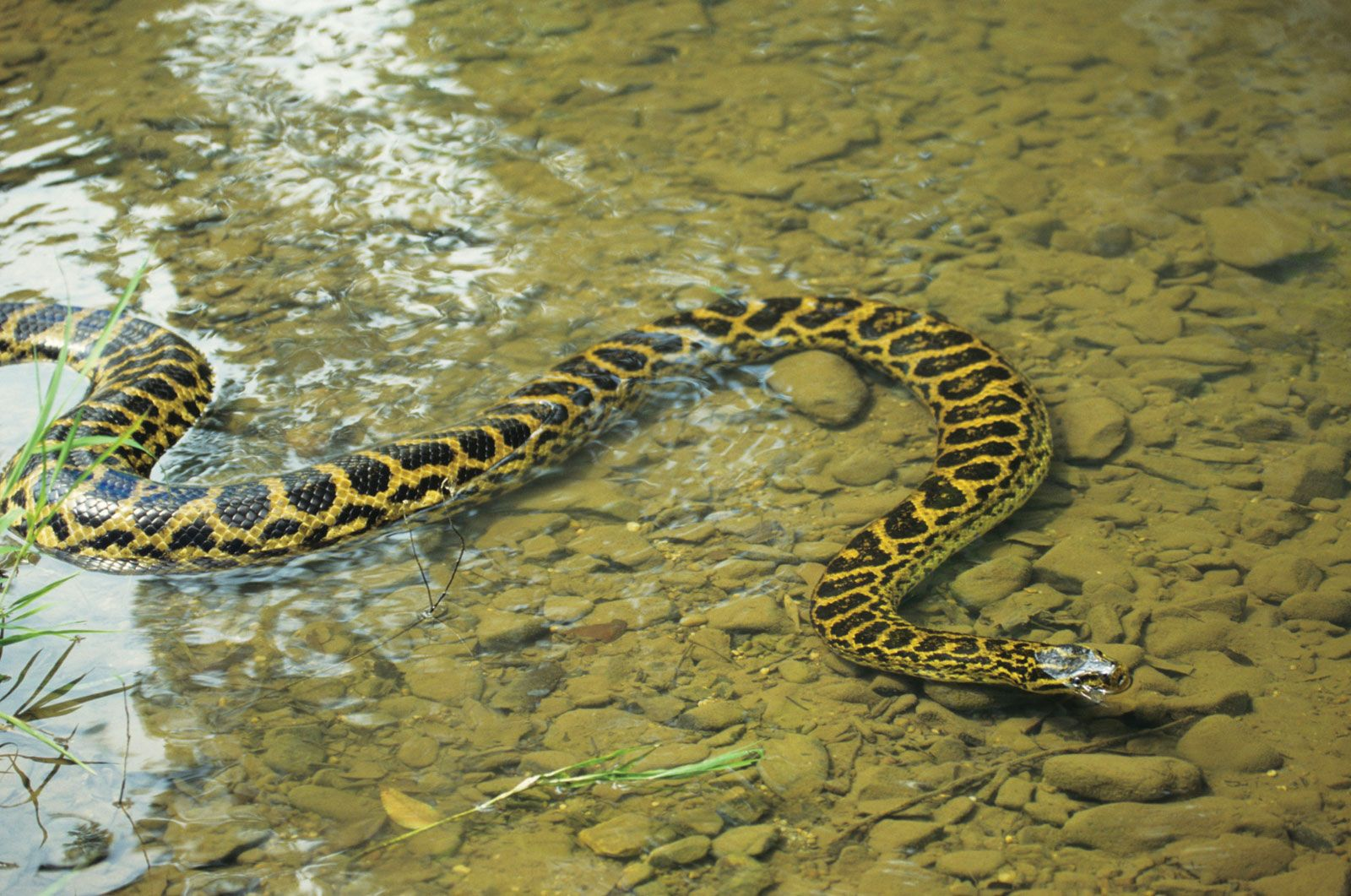
The Yellow Anaconda is a large, non-venomous snake with dark saddles and spots over a golden to greenish-yellow body.
It has a broad head, raised eyes for hunting at the water’s surface, and strong muscles with specialized scales for smooth movement in water and on land.
| Scientific Name | Eunectes notaeus |
|---|---|
| Origin | South America |
| Habitat | Slow-moving rivers, swamps, marshes, and wetlands in Paraguay, Brazil, Bolivia, and Argentina |
| Fun Fact | Though smaller than its green cousin, this snake can still reach lengths of 13 feet and possesses jaw ligaments that allow it to swallow prey three times the size of its head. |
9. Yellow Baboon
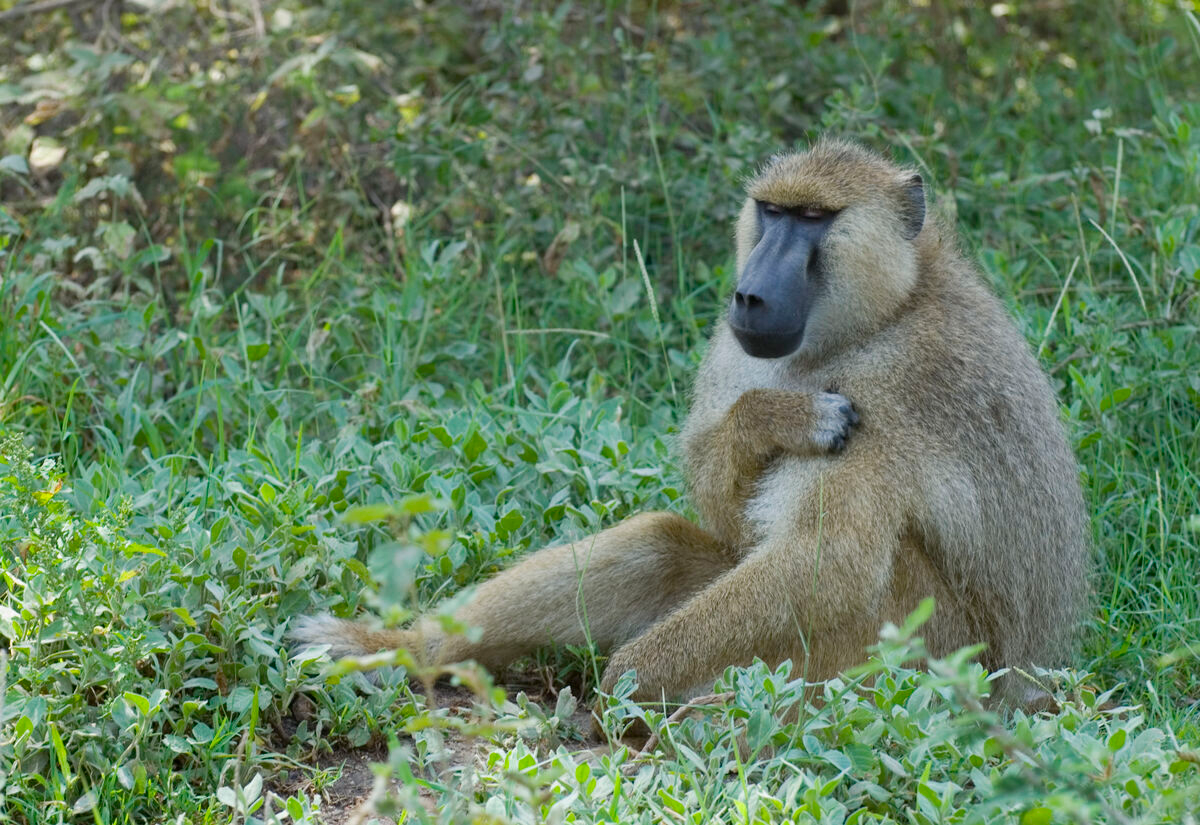
The Yellow Baboon has an elongated doglike muzzle, powerful jaws with sharp canine teeth, and a coat of coarse yellowish-brown fur that gives the species its common name.
It features distinctive ridged brow bones, a long tail held in a characteristic arch, and muscular limbs of nearly equal length that facilitate its quadrupedal movement across various terrains.
| Scientific Name | Papio cynocephalus |
|---|---|
| Origin | East Africa |
| Habitat | Savannas, woodlands, and light forests of Kenya, Tanzania, and other parts of eastern Africa |
| Fun Fact | These highly intelligent primates form complex social structures with up to 200 individuals and have been observed using over 30 distinct vocalizations to communicate. |
10. Yellow-Eyed Penguin
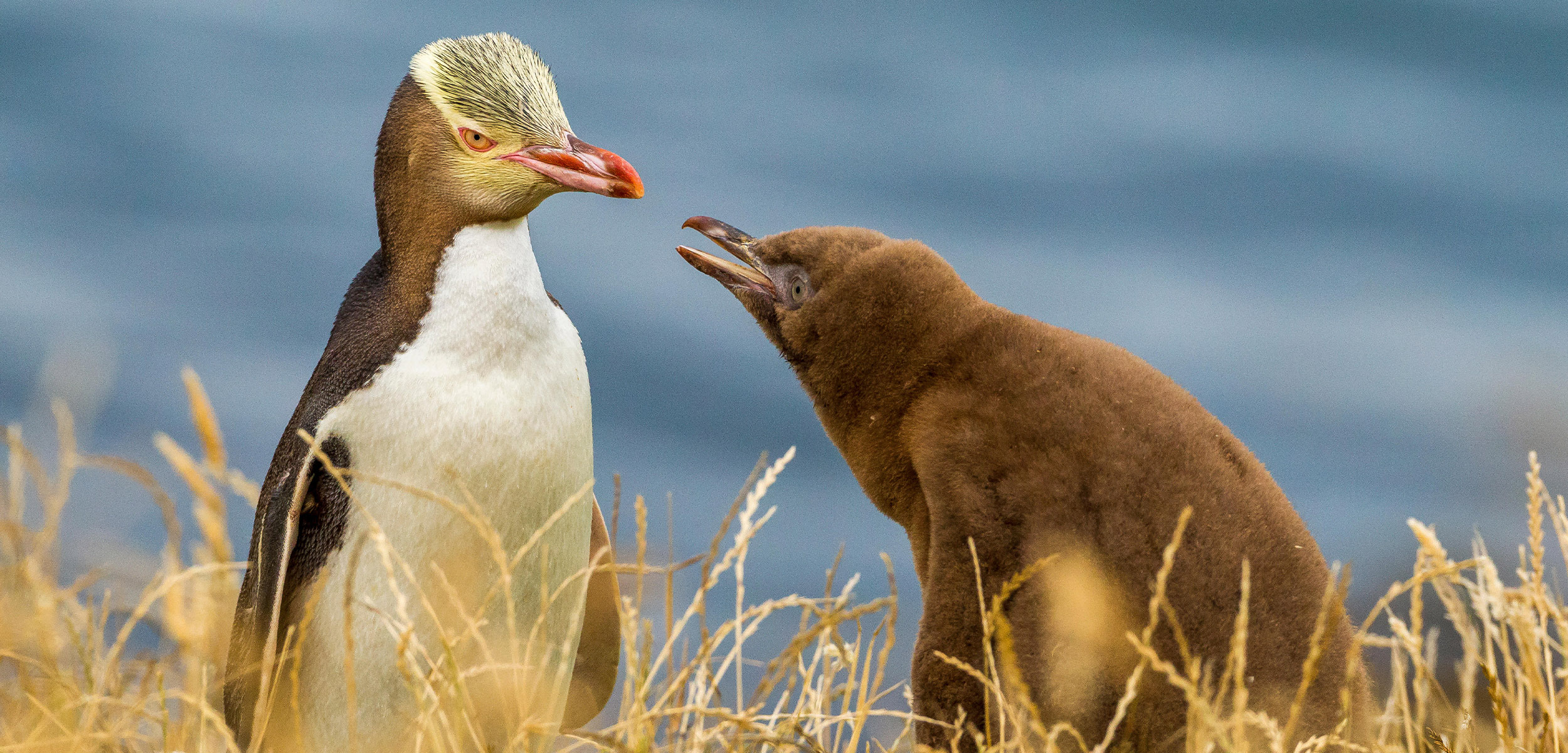
The Yellow-Eyed Penguin has a slate-gray back, white underparts, and the distinctive pale yellow band of feathers that wraps around the back of its head and the yellow iris of its eyes that gives it its name.
It stands about 65 cm tall with a robust body, powerful flippers for swimming, and strong legs positioned far back on its body, giving it the characteristic penguin waddle when walking on land.
| Scientific Name | Megadyptes antipodes |
|---|---|
| Origin | New Zealand |
| Habitat | Coastal forests and shrubland for nesting; forages in the surrounding ocean waters |
| Fun Fact | This is one of the rarest penguin species in the world with only about 4,000 individuals remaining, and unlike most other penguins, it generally avoids nesting in colonies. |
11. Yellow-Bellied Marmot
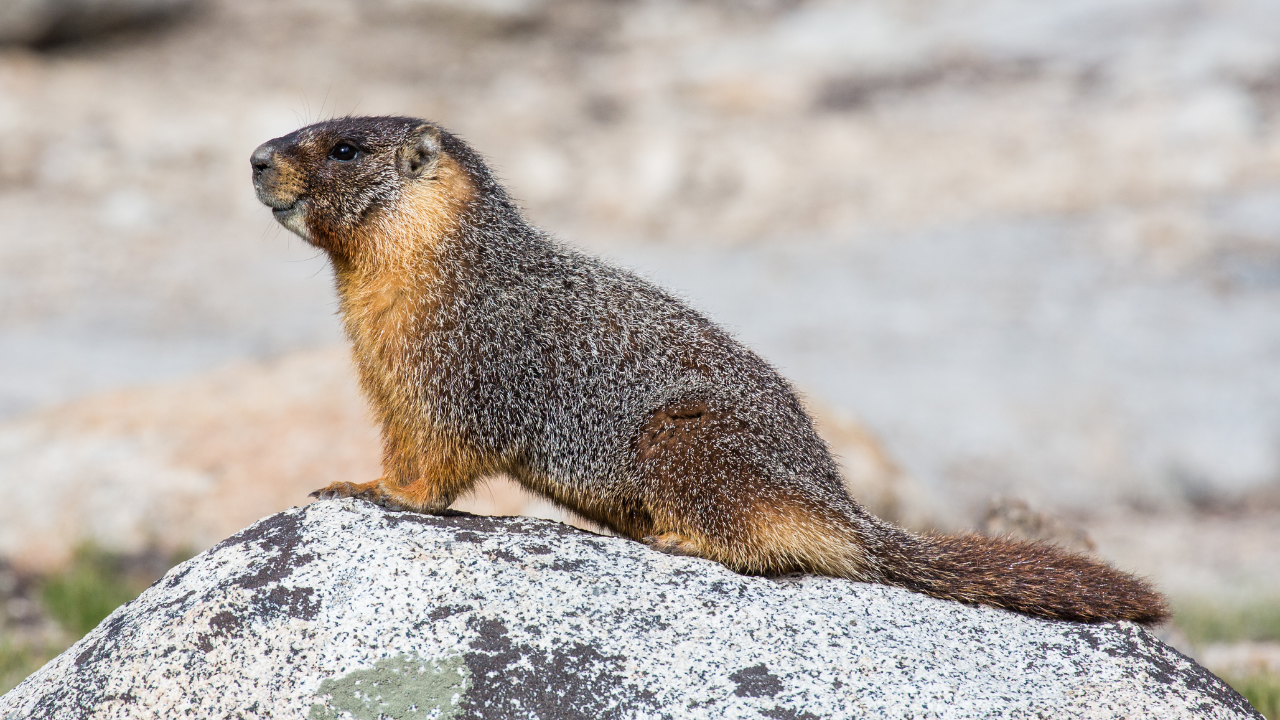
The Yellow-Bellied Marmot is a large, stout-bodied ground squirrel with grizzled brownish fur on its back, a distinctive yellow-orange belly, and small rounded ears set on a broad head.
It has powerful limbs adapted for digging extensive burrow systems and sharp incisors that continuously grow throughout its lifetime for gnawing on tough plant material.
| Scientific Name | Marmota flaviventris |
|---|---|
| Origin | North America |
| Habitat | Rocky mountain regions of western United States and southwestern Canada |
| Fun Fact | These social animals can whistle loud alarm calls that earned them the nickname “whistle pigs.” |
12. Yellow-Tailed Black Cockatoo
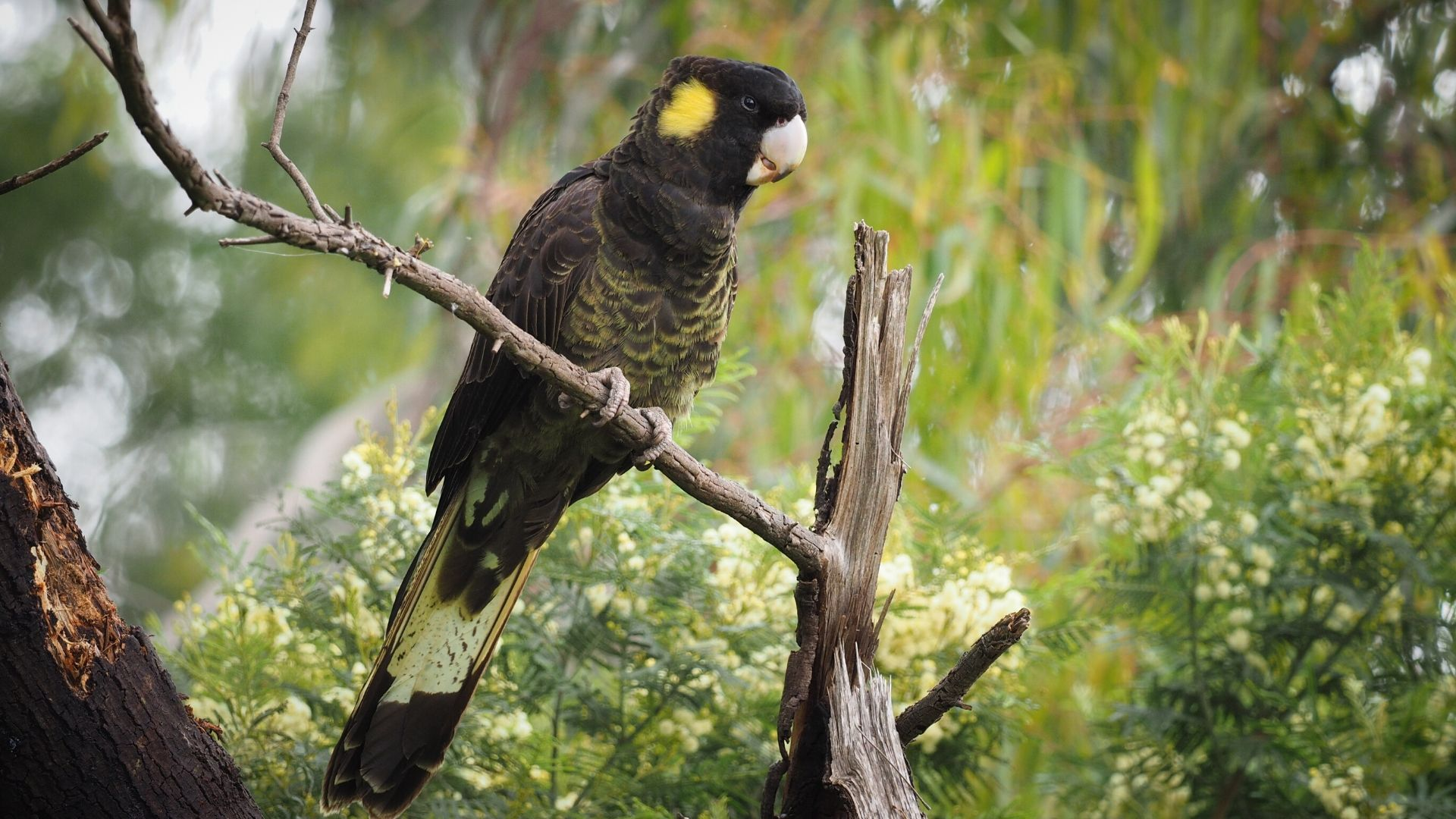
The Yellow-Tailed Black Cockatoo has a primarily black plumage with distinctive yellow panels on its tail and yellow patches near its ears that contrast strikingly against its dark feathers.
It possesses a massive curved bill adapted for extracting seeds from native trees and woody fruits, and a long tail that helps it maneuver through forest canopies.
| Scientific Name | Calyptorhynchus funereus |
|---|---|
| Origin | Australia |
| Habitat | Eucalyptus forests and woodlands in eastern and southeastern Australia |
| Fun Fact | These birds can detect insect larvae hidden under bark by listening for their movement. |
13. Yellow Mongoose
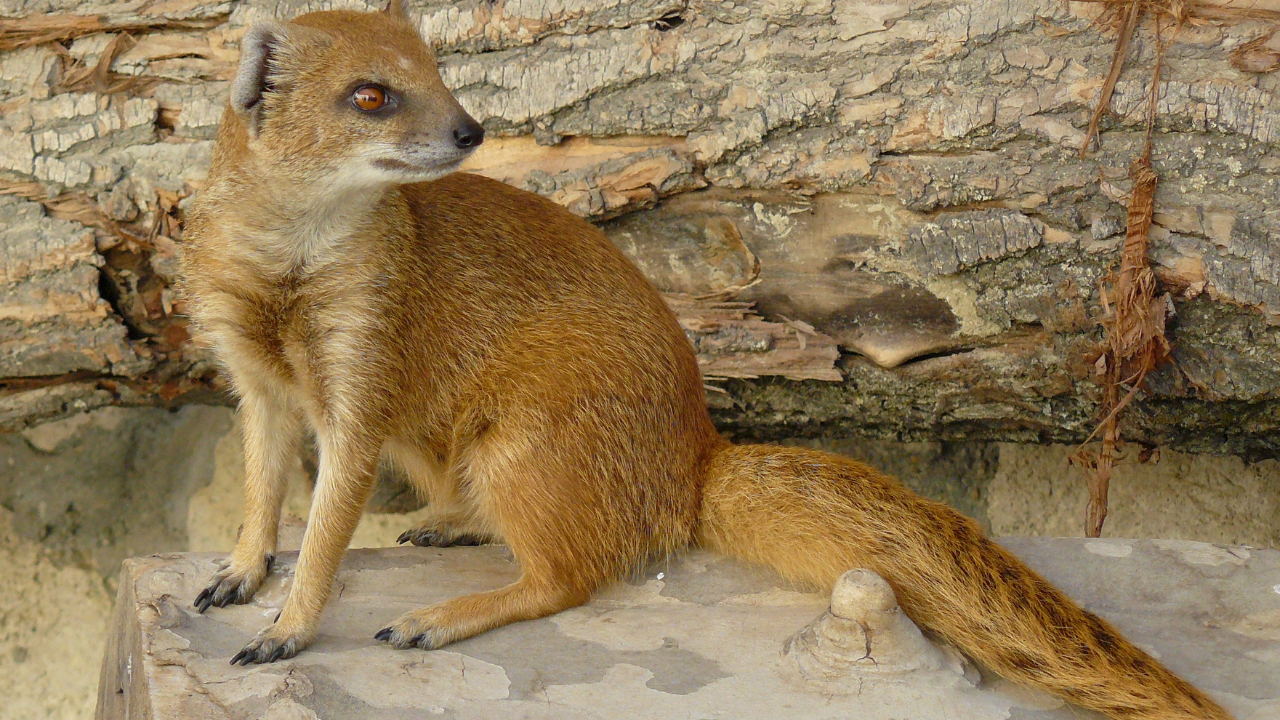
The Yellow Mongoose has a slender body with a sleek golden-yellow to tawny-brown coat, a pointed muzzle, and a long, bushy tail with a distinctive white tip used for signaling.
It possesses specialized teeth for crushing insect exoskeletons and small bones, and curved claws ideal for digging both burrows and when searching for prey.
| Scientific Name | Cynictis penicillata |
|---|---|
| Origin | Africa |
| Habitat | Open, arid grasslands and semi-deserts of southern Africa |
| Fun Fact | Unlike most mongoose species, they live in permanent social groups with complex tunnel systems. |
14. Yellow-Billed Hornbill
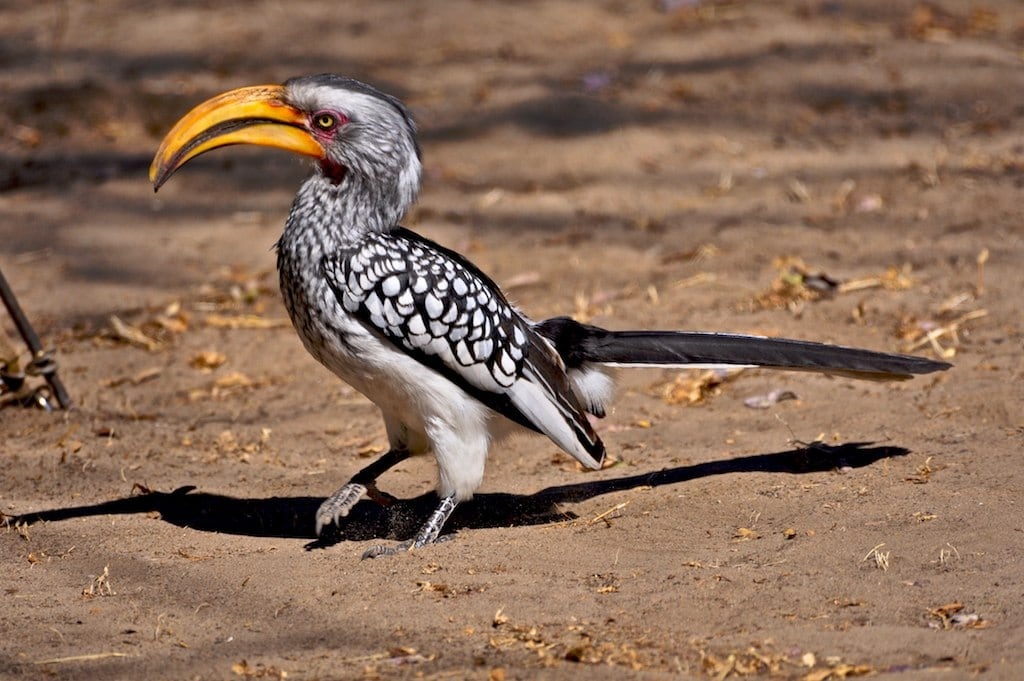
The Yellow-Billed Hornbill has a predominantly white to gray body with black wings and tail, and a large, curved, bright yellow bill topped with a small casque (horn-like structure).
It has long eyelashes that protect its eyes from dust, and a long neck that allows it to probe deep into crevices for food items ranging from insects to small vertebrates.
| Scientific Name | Tockus leucomelas |
|---|---|
| Origin | Africa |
| Habitat | Savannas, woodlands, and thorn scrub in southern and eastern Africa |
| Fun Fact | Females seal themselves inside tree cavities during nesting, surviving on food deliveries through a small slit. |
15. Yellow Ground Squirrel
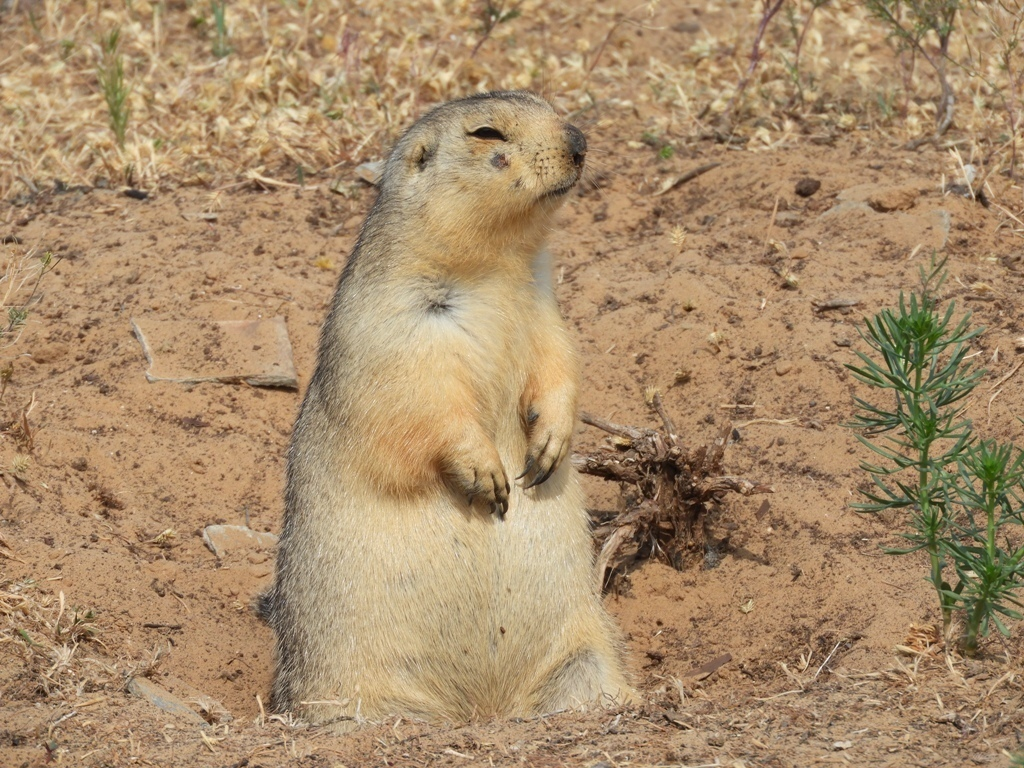
The Yellow Ground Squirrel has a robust body covered in short, dense fur that ranges from yellowish-tan to rich golden on its back and paler cream on its underside.
It possesses large cheek pouches for carrying seeds and grains, strong front limbs with curved claws for digging complex burrow systems, and a moderately bushy tail used for balance.
| Scientific Name | Spermophilus fulvus |
|---|---|
| Origin | Asia |
| Habitat | Dry steppes, semi-deserts, and agricultural lands of Central Asia |
| Fun Fact | These squirrels hibernate for up to nine months a year in harsh environments. |
16. Yabby
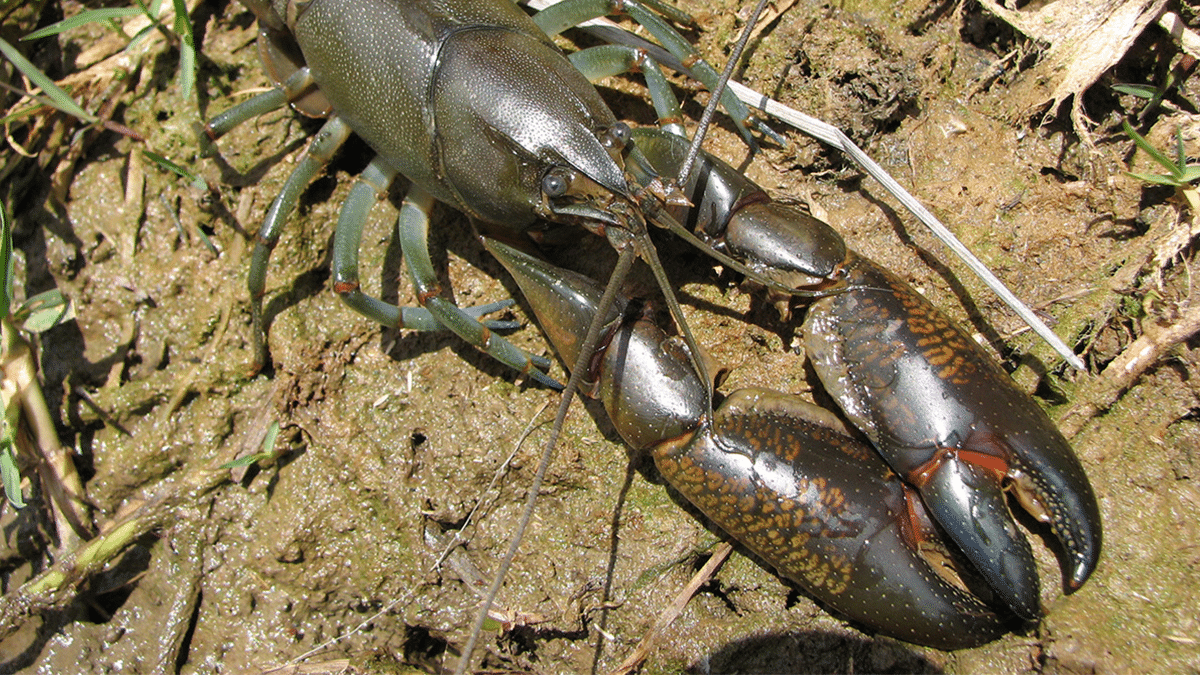
The Yabby is a medium freshwater crayfish with a smooth blue-gray to green-brown shell, strong front claws, and gills under its abdomen for breathing.
It has jointed legs, long sensory antennae, and compound eyes on stalks for spotting movement in water.
| Scientific Name | Cherax destructor |
|---|---|
| Origin | Australia |
| Habitat | Rivers, lakes, farm dams, and irrigation channels across much of Australia |
| Fun Fact | Yabbies can survive drought by sealing themselves in burrows up to 2 meters deep for years. |
17. Yellowtail Snapper
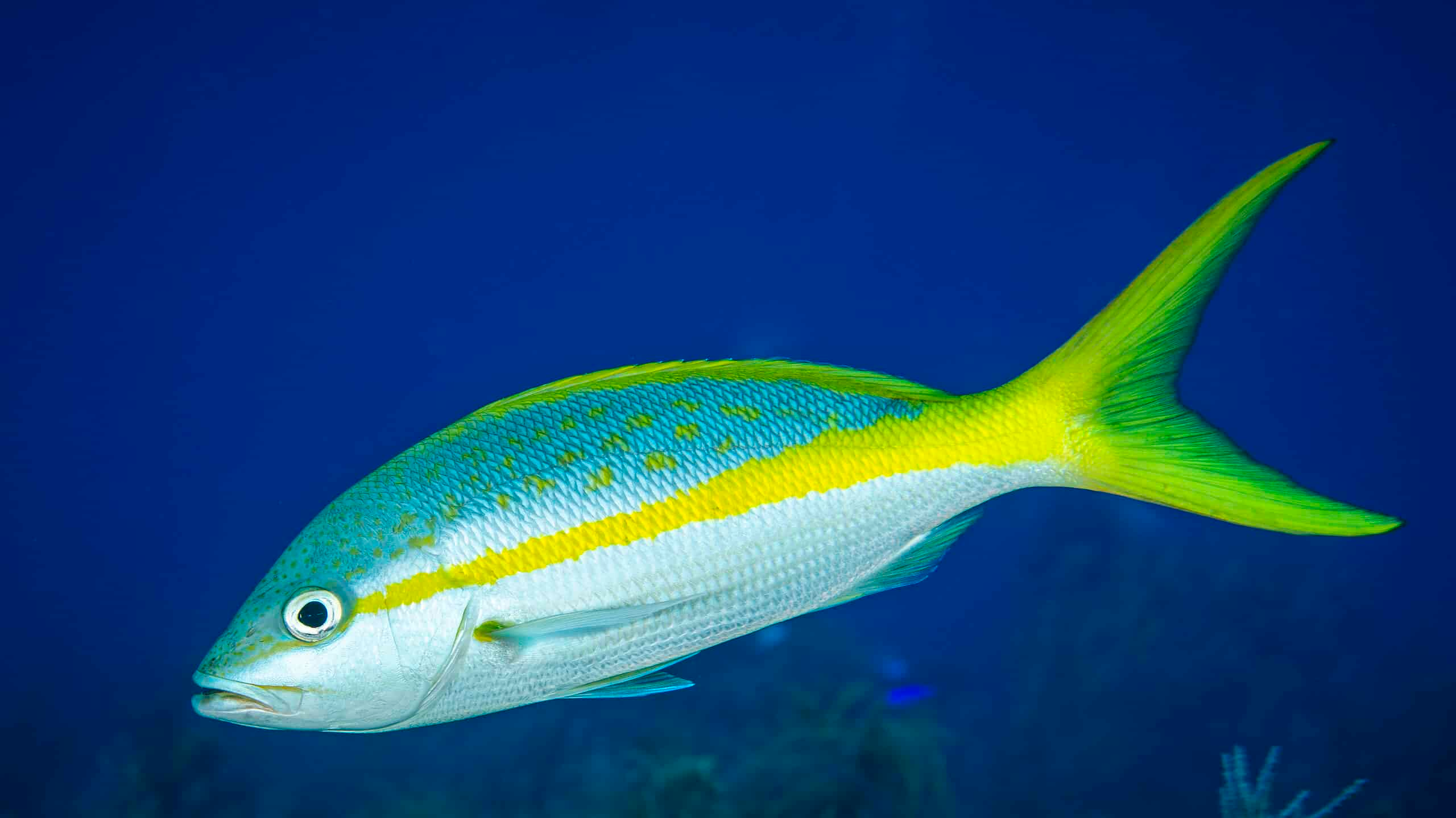
The Yellowtail Snapper has a sleek body with an olive-blue top, white underside, and a bright yellow stripe leading to its forked yellow tail.
It has high-set eyes for spotting prey, sharp teeth, and fins built for quick bursts and agile movements around reefs.
| Scientific Name | Ocyurus chrysurus |
|---|---|
| Origin | Atlantic Ocean |
| Habitat | Coral reefs and adjacent sandy areas in the western Atlantic and Caribbean |
| Fun Fact | These fish can change their coloration intensity to blend with their surroundings within minutes. |
18. Yellow-Throated Marten
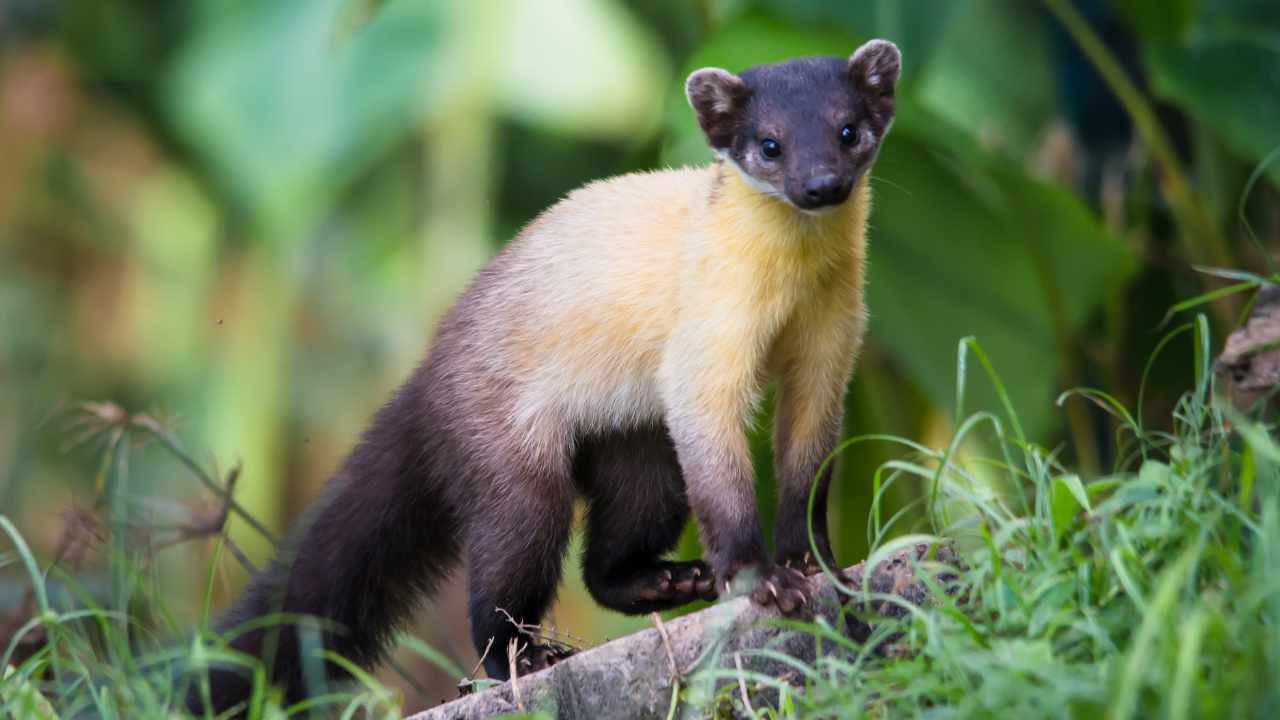
The Yellow-Throated Marten has a long, slender body with glossy dark brown to black fur that contrasts dramatically with its bright golden-yellow throat and chest patch.
It possesses a bushy tail nearly as long as its body, retractable claws for climbing, and specialized teeth for its omnivorous diet that includes everything from fruits to small deer.
| Scientific Name | Martes flavigula |
|---|---|
| Origin | Asia |
| Habitat | Tropical and subtropical forests across southern and eastern Asia |
| Fun Fact | Despite weighing only 3kg, these fierce predators can take down musk deer ten times their size. |
19. Yellow-Backed Duiker
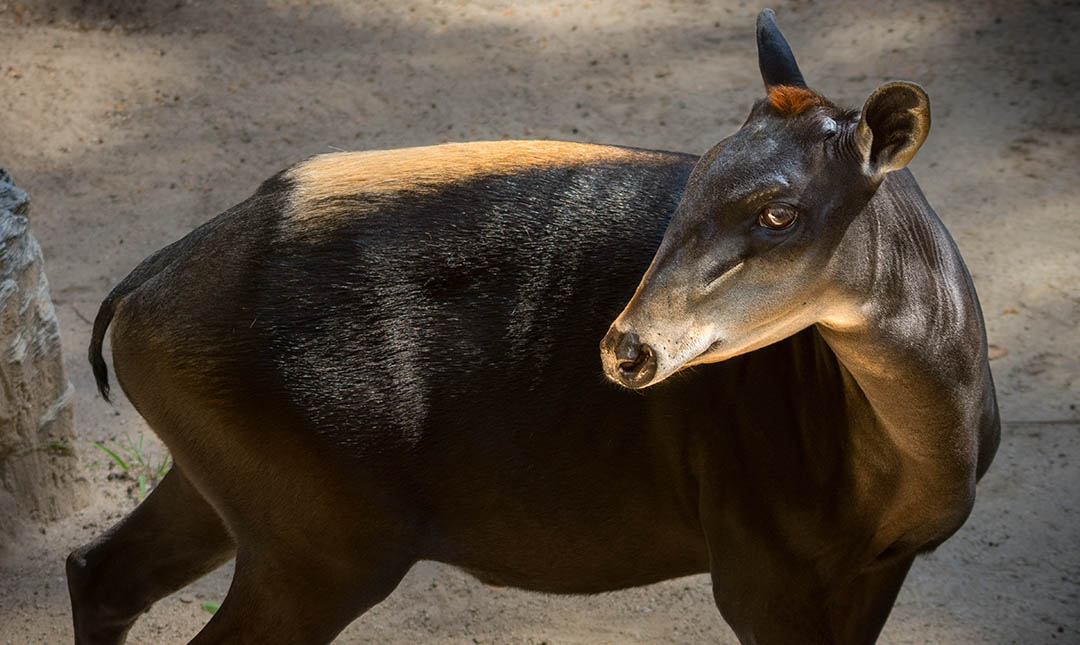
The Yellow-Backed Duiker is a medium-sized forest antelope with a distinctive patch of yellow-gold hair along its spine contrasting against its otherwise dark brown to black coat.
It has short, straight horns present in both sexes, large eyes adapted for low-light forest conditions, and specialized two-toed hooves that allow silent movement through dense vegetation.
| Scientific Name | Cephalophus silvicultor |
|---|---|
| Origin | Africa |
| Habitat | Dense rainforests and secondary forests across Central and Western Africa |
| Fun Fact | They create networks of tunnel-like paths through dense forest undergrowth that they regularly patrol. |
20. Yellow-Spotted Lizard
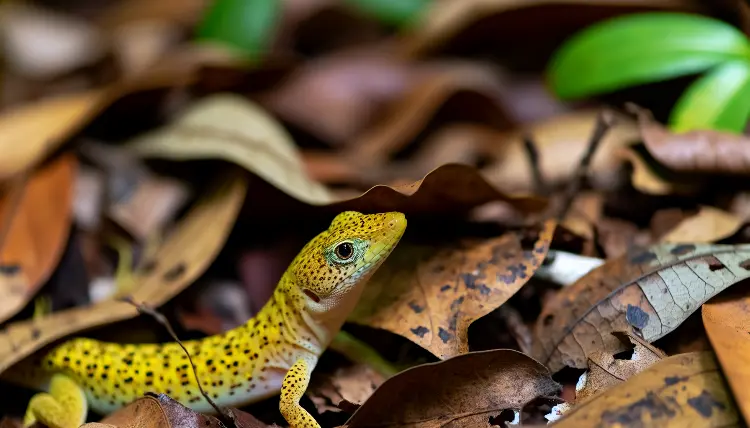
The Yellow-Spotted Lizard has a dark body with bright yellow spots, strong limbs, and ridges above its eyes.
It has venom-linked teeth, a forked tongue for sensing its surroundings, and rough, beaded scales for a textured look.
| Scientific Name | Heloderma suspectum (Gila Monster) |
|---|---|
| Origin | North America |
| Habitat | Arid regions including deserts and dry foothills in southwestern United States and Mexico |
| Fun Fact | Its venom has led to the development of a medication for treating type 2 diabetes. |
21. Yellowhammer
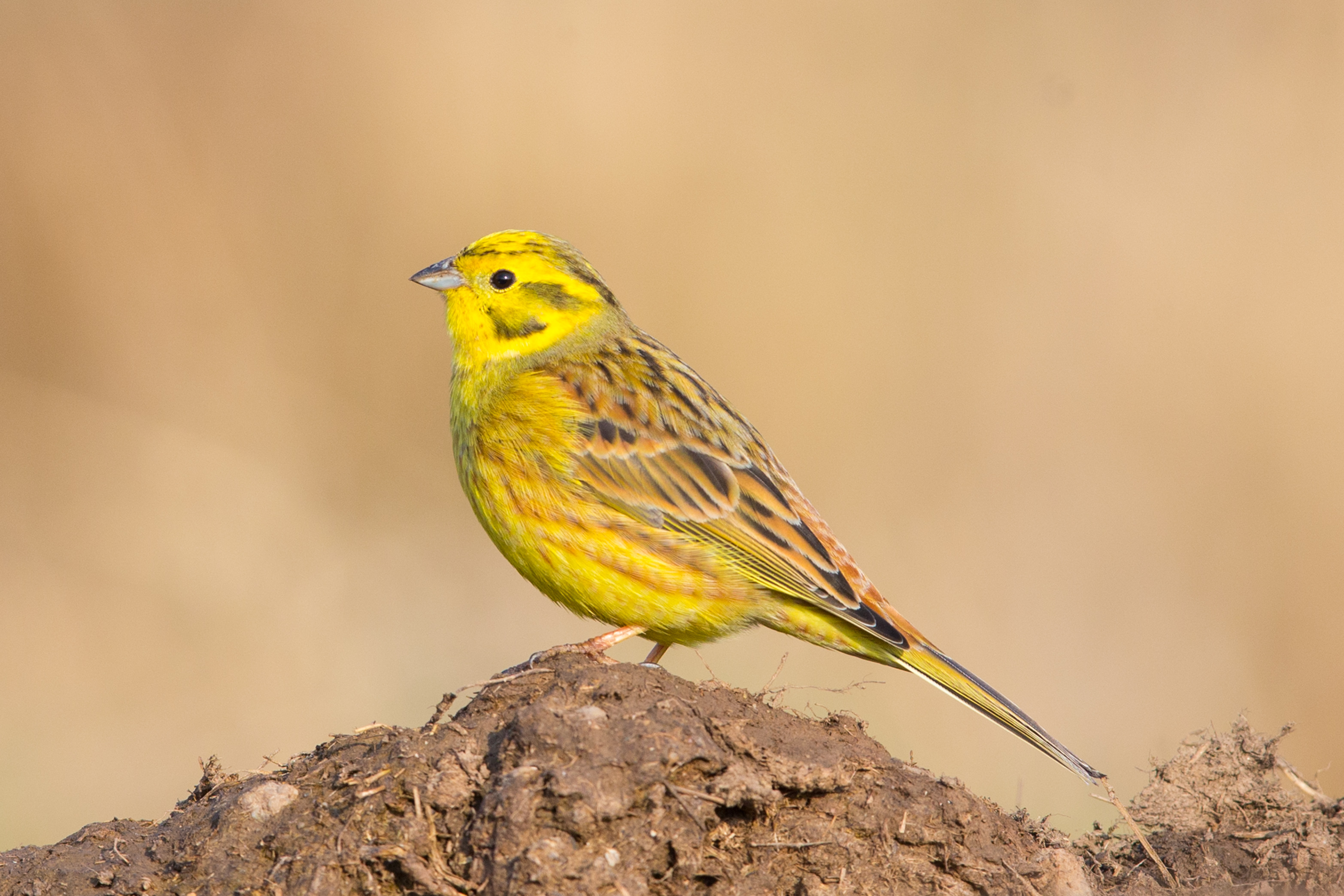
The Yellowhammer is a small, bright bunting with a yellow head and belly, a streaked brown back, and a chestnut rump seen in flight.
It has a seed-crushing conical bill, sings a melodic “a-little-bit-of-bread-and-no-cheese” tune, and often perches atop hedges and bushes.
| Scientific Name | Emberiza citrinella |
|---|---|
| Origin | Europe and Asia |
| Habitat | Farmland, hedgerows, scrubland, and the edges of woodlands across Europe and parts of Asia |
| Fun Fact | Beethoven reportedly used this bird’s distinctive song as inspiration for the opening notes of his Fifth Symphony. |
22. Yellow-Footed Rock Wallaby
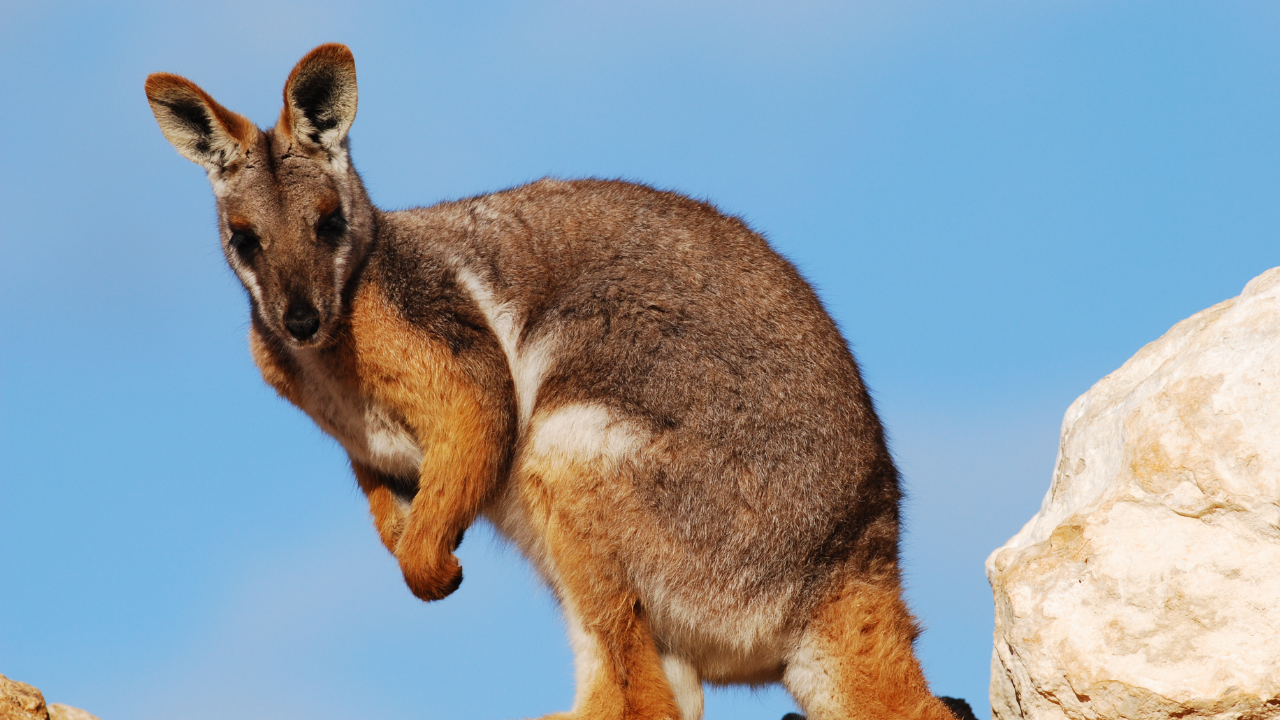
The Yellow-Footed Rock Wallaby has striking coloration with gray-brown fur, white stripes on its face, and distinctive yellow-orange feet, hands, and tail base.
It possesses powerful hind legs for leaping between rock faces, a long tail used for balance during hopping and climbing, and specialized foot pads that provide exceptional grip on smooth rock surfaces.
| Scientific Name | Petrogale xanthopus |
|---|---|
| Origin | Australia |
| Habitat | Rocky outcrops, cliffs, and boulder piles in semi-arid regions of South Australia, New South Wales, and Queensland |
| Fun Fact | Their striped tails act as signals to help group members follow each other through complex terrain. |
23. Yellow-Vented Bulbul
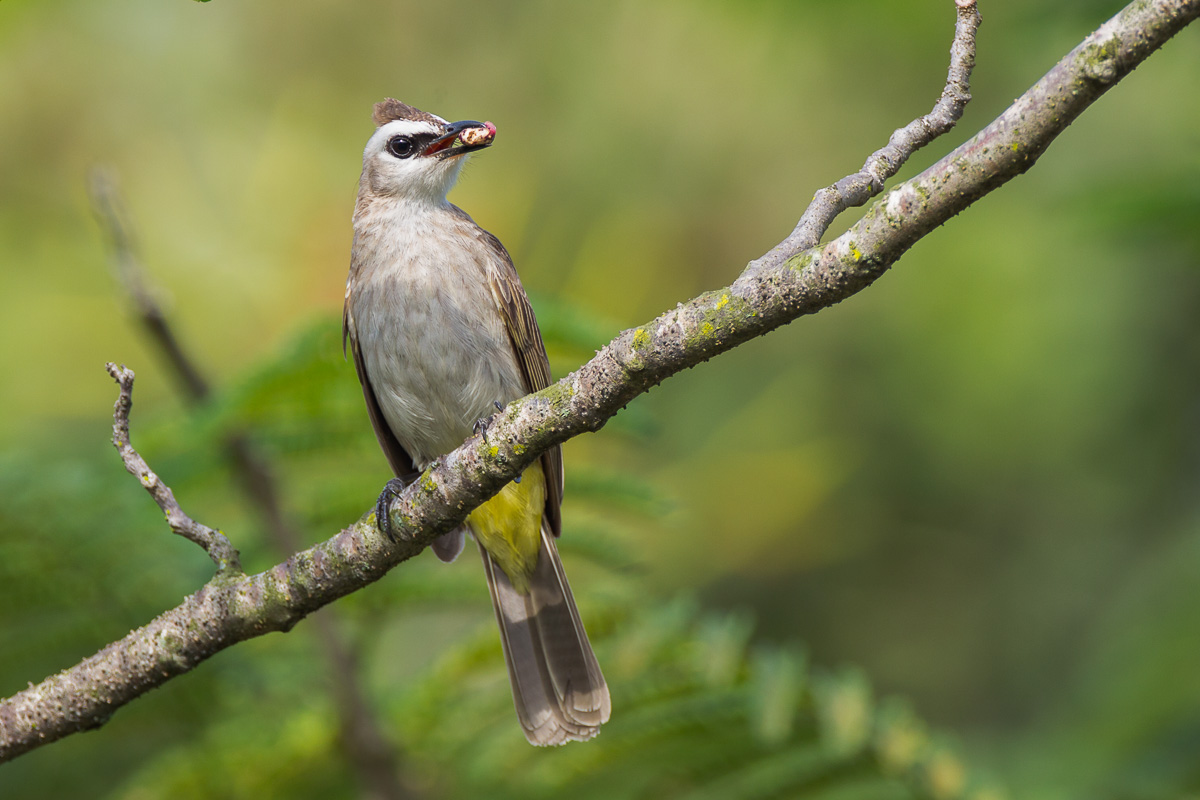
The Yellow-Vented Bulbul has a predominantly brown-gray body, a slightly crested black head, distinctive white cheeks, and the yellow patch beneath its tail that gives it its name.
It possesses a slightly curved bill ideal for its omnivorous diet, a melodious warbling call, and an adaptable nature that has allowed it to thrive in both natural and urban environments.
| Scientific Name | Pycnonotus goiavier |
|---|---|
| Origin | Southeast Asia |
| Habitat | Gardens, parks, secondary growth, and forest edges across Southeast Asia |
| Fun Fact | These adaptable birds have learned to recognize and follow farmers who plow fields, swooping in to catch exposed insects. |
24. Yunnan Snub-Nosed Monkey
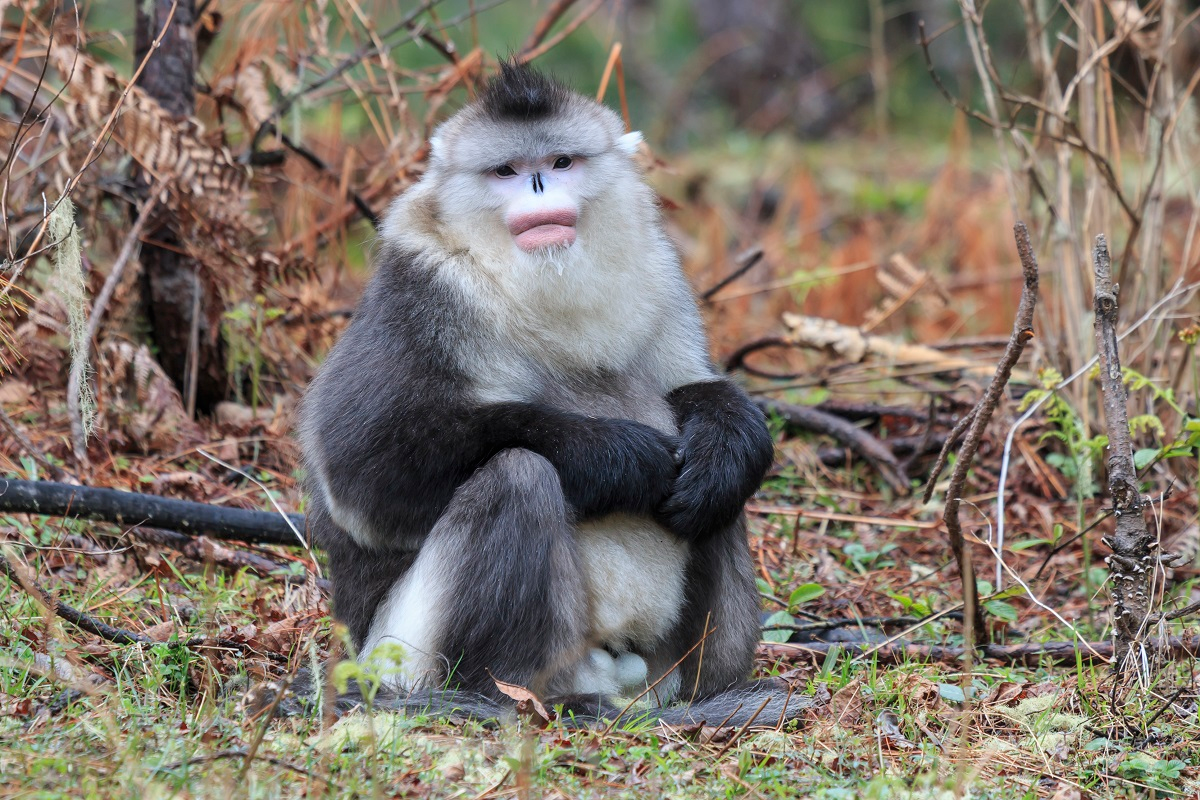
The Yunnan Snub-Nosed Monkey has upturned nostrils, a flat nose, and a thick bluish-black coat with white patches and long fur suited for cold mountain climates.
It has a digestive system for eating lichen, facial skin that shifts color with emotion, and strong limbs for agile movement through trees.
| Scientific Name | Rhinopithecus bieti |
|---|---|
| Origin | China |
| Habitat | High-altitude forests in the mountains of southwestern China, particularly in Yunnan province |
| Fun Fact | They live at higher elevations than any other non-human primate, surviving in temperatures that regularly drop below freezing. |
25. Yacare Caiman
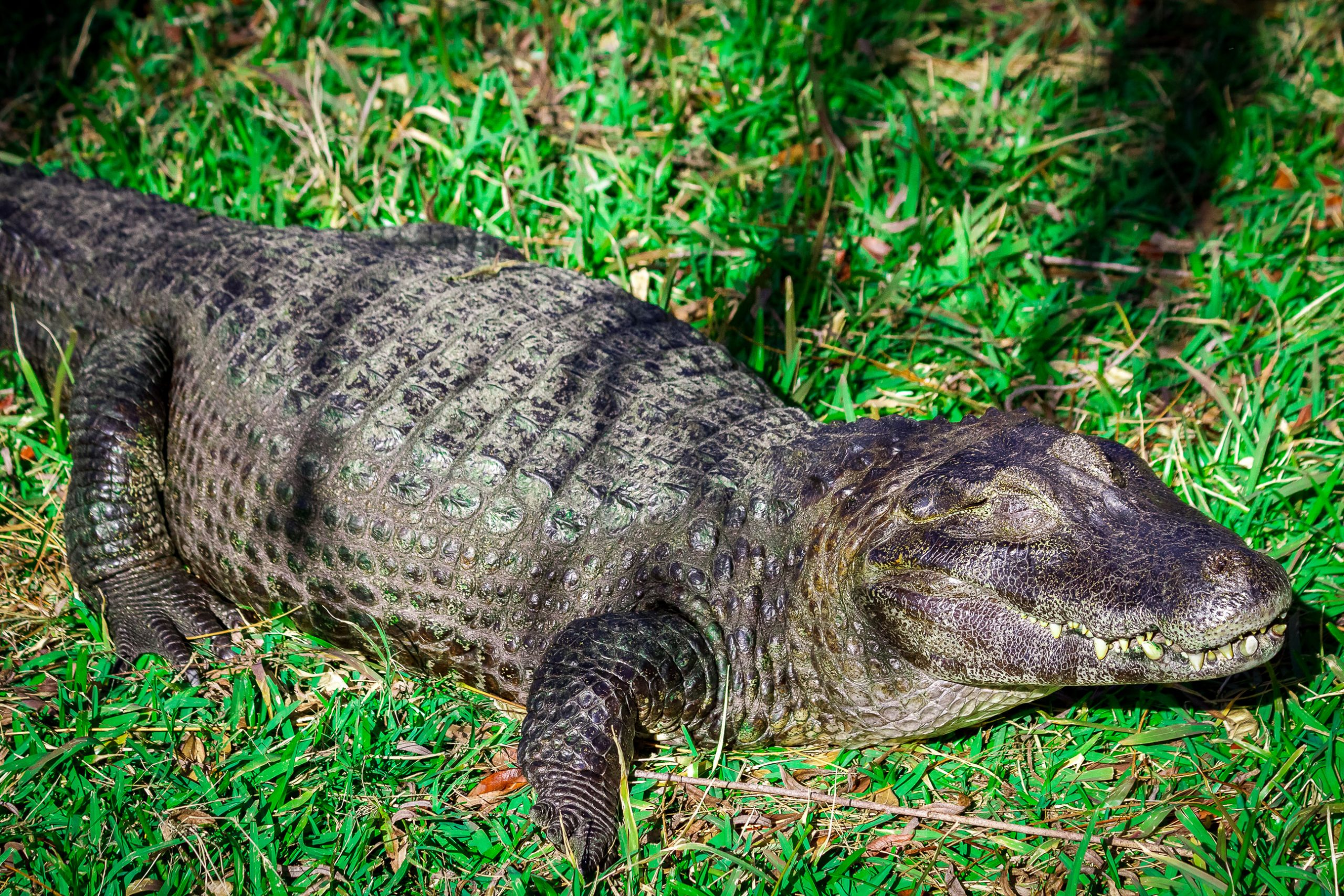
The Yacare Caiman is a medium-sized crocodilian with a broad snout, bony eye ridges, and tough, armored skin made of bony plates covered in scales.
It has strong jaws with sharp conical teeth, eyes and nostrils on top of its head for breathing while submerged, and a muscular, side-flattened tail for swift swimming.
| Scientific Name | Caiman yacare |
|---|---|
| Origin | South America |
| Habitat | Rivers, lakes, wetlands, and flooded savannas in central South America, primarily in the Pantanal region |
| Fun Fact | Despite their fearsome appearance, females are incredibly gentle when handling their newly hatched young. |
26. Yucatan Squirrel
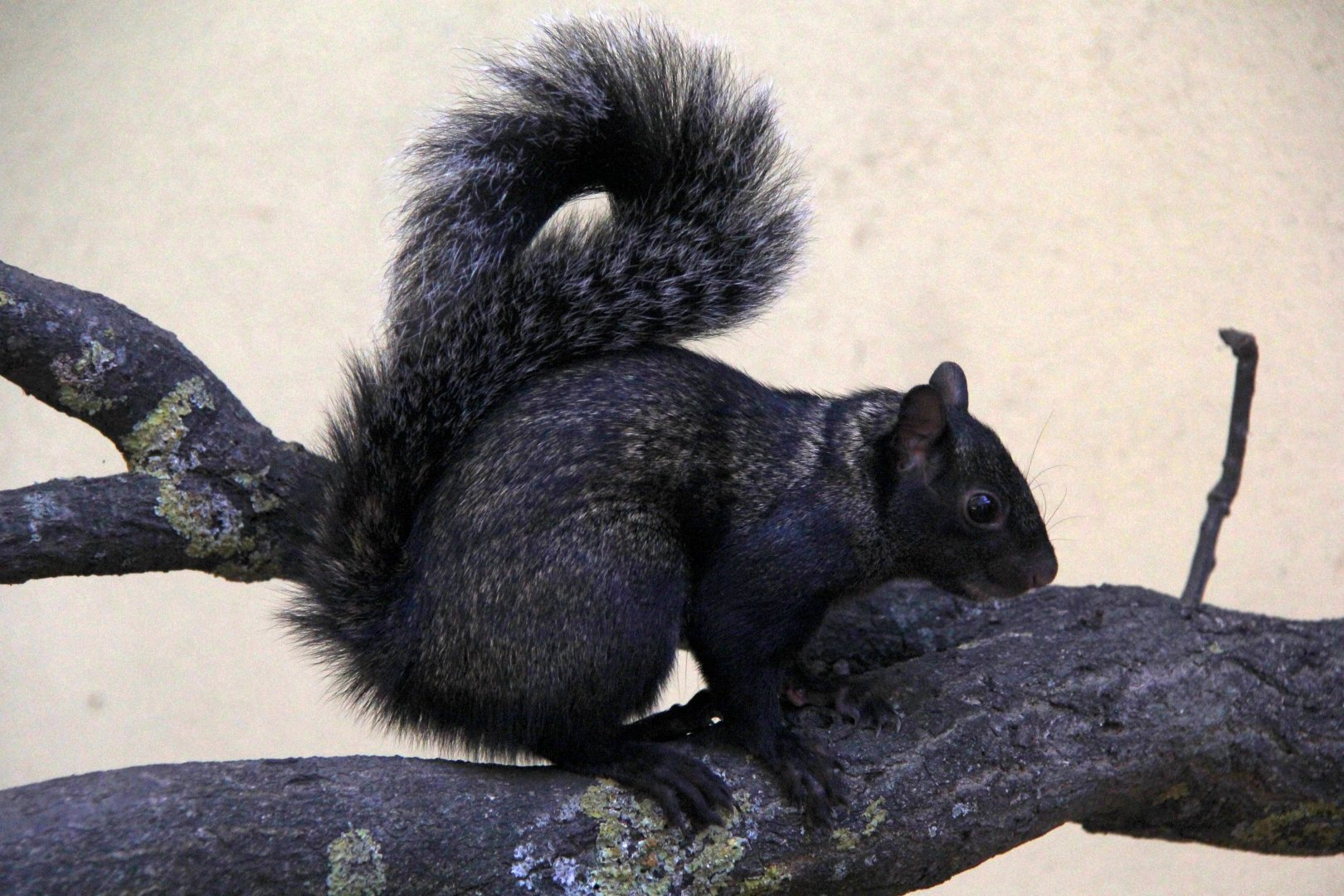
The Yucatan Squirrel has a reddish-brown to gray coat, a pale underside, and a bushy tail used for balance and signaling.
It has sharp, ever-growing incisors for cracking nuts, sharp vision for spotting predators, and nimble front paws for handling food.
| Scientific Name | Sciurus yucatanensis |
|---|---|
| Origin | Central America |
| Habitat | Tropical forests and forest edges in the Yucatan Peninsula of Mexico, Belize, and Guatemala |
| Fun Fact | These squirrels create multiple “dummy nests” to confuse predators about the location of their actual home. |
27. Yellow-Necked Mouse
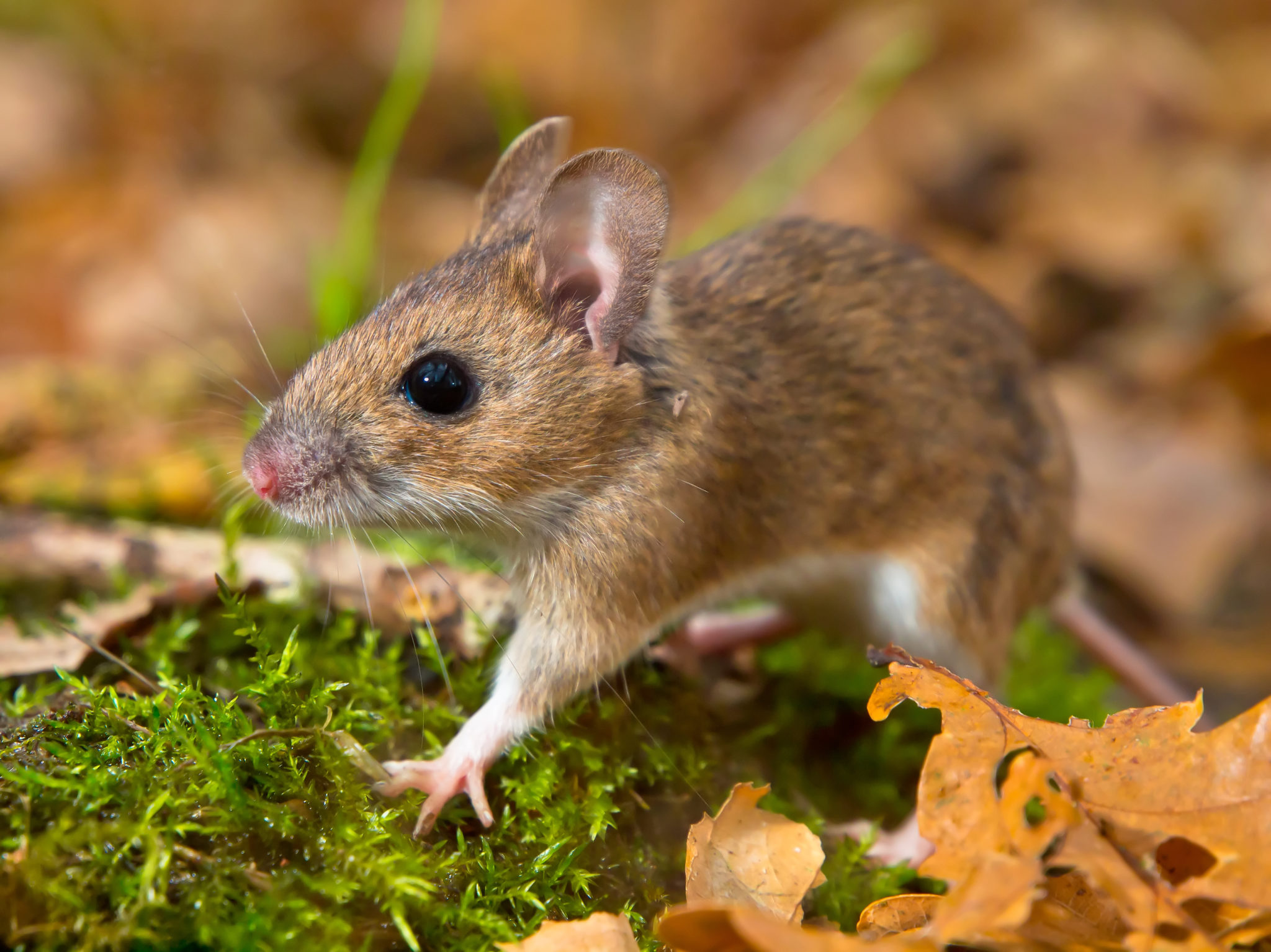
The Yellow-Necked Mouse has a yellow-orange band on its chest, a tawny-brown back, and a white underside.
It features large ears and eyes, a long tail for balance when climbing, and ever-growing incisors for gnawing.
| Scientific Name | Apodemus flavicollis |
|---|---|
| Origin | Europe and parts of Asia |
| Habitat | Mature deciduous woodlands, particularly those with oak, beech, and hazel trees |
| Fun Fact | They can leap distances of over 80cm and are excellent climbers, often foraging high in the canopy. |
28. Yellow-Crowned Amazon
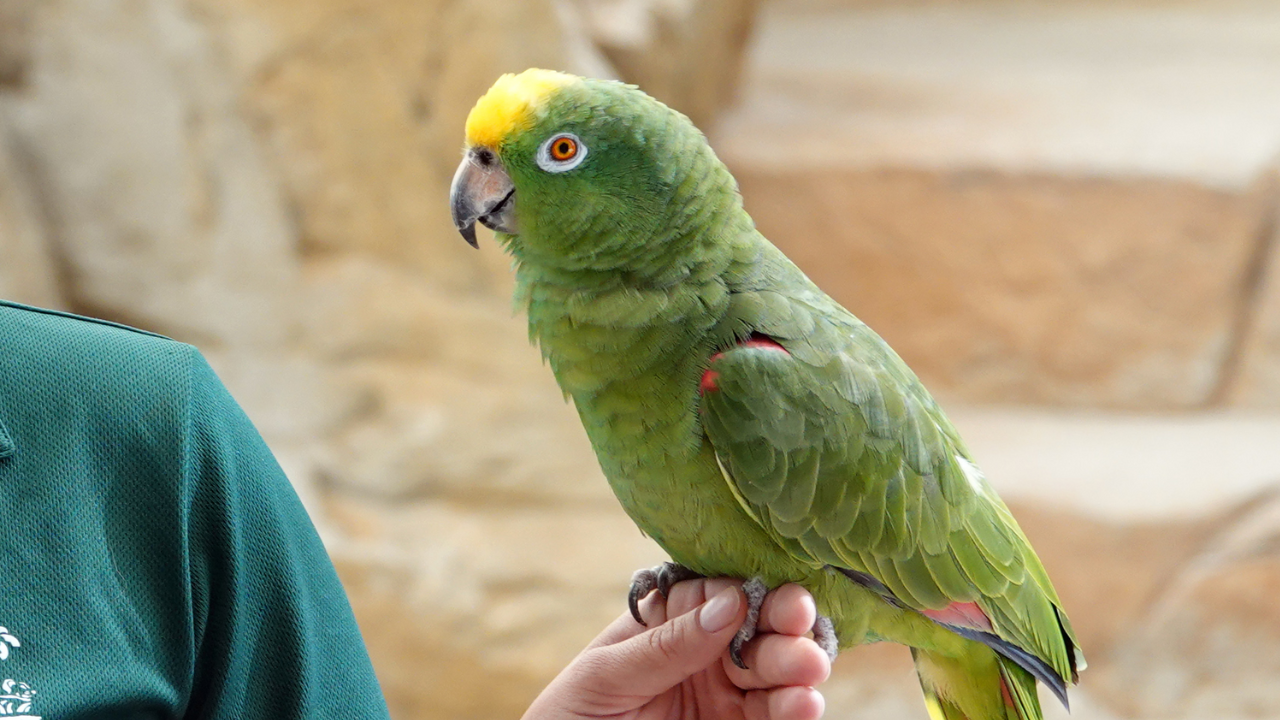
The Yellow-Crowned Amazon is a green parrot with a yellow forehead and occasional red on its wings and shoulders.
It has a strong hooked bill for cracking nuts, zygodactyl feet for gripping, and can mimic human speech.
| Scientific Name | Amazona ochrocephala |
|---|---|
| Origin | Central and South America |
| Habitat | Tropical and subtropical forests, savanna edges, and mangroves from Mexico to South America |
| Fun Fact | These intelligent birds can develop vocabularies of up to 100 words and phrases with proper socialization. |
29. Yellow-Pine Chipmunk
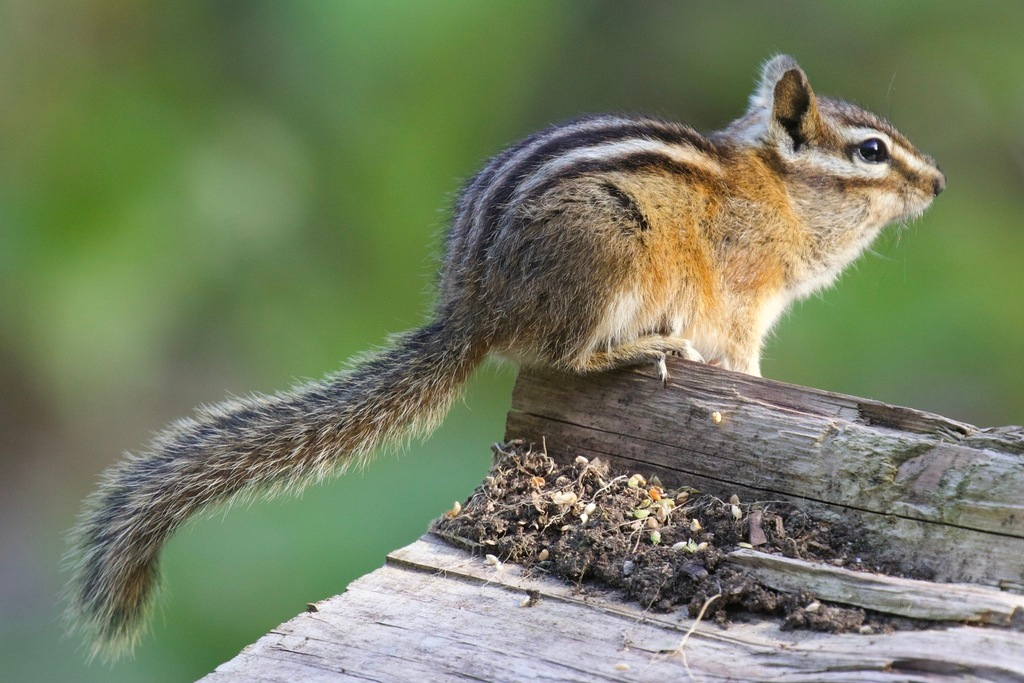
The Yellow-Pine Chipmunk has a small, compact body with alternating dark and light stripes running along its back and sides, and yellowish-gray fur interspersed with russet tones.
It possesses large cheek pouches for carrying seeds and nuts, a bushy tail held upright when running, and specialized teeth that allow it to open pine cones with remarkable efficiency.
| Scientific Name | Tamias amoenus |
|---|---|
| Origin | North America |
| Habitat | Coniferous forests, particularly those dominated by yellow pines, across western United States and Canada |
| Fun Fact | One chipmunk can gather and store up to 68,000 seeds in a single season for winter provisions. |
30. Yellow-Headed Gecko
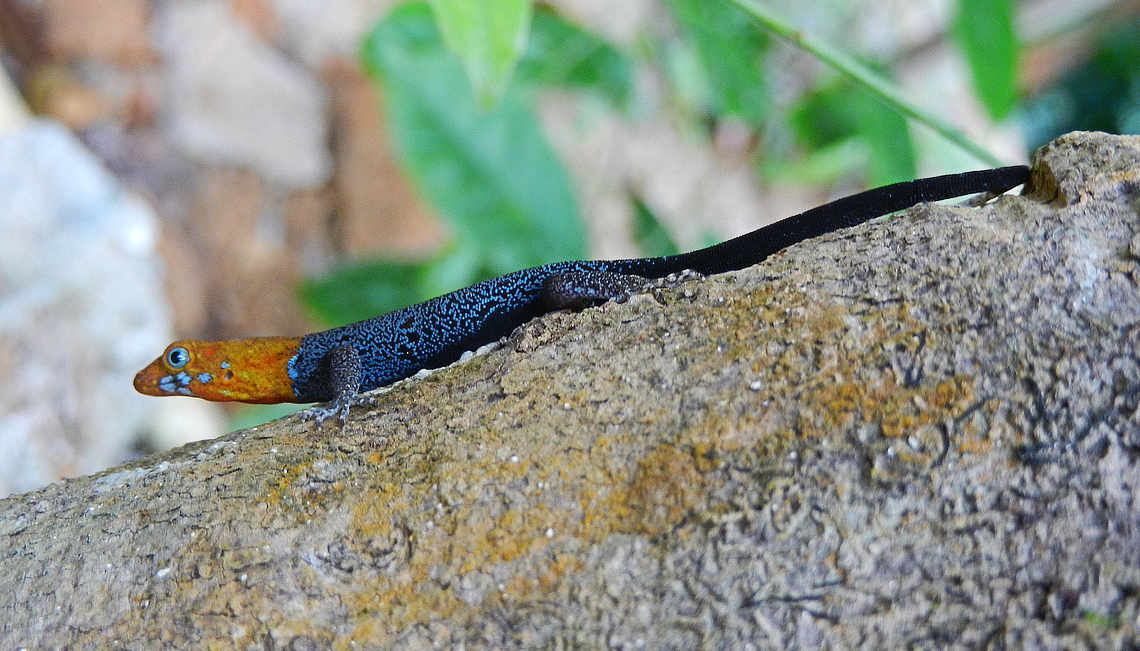
The Yellow-Headed Gecko has a golden-yellow head, a grayish-brown body, and large, lidless eyes with vertical pupils for night vision.
It has toe pads with tiny hair-like structures for climbing smooth surfaces and a tail that detaches to escape predators.
| Scientific Name | Gonatodes albogularis |
| Origin | Central and South America |
| Habitat | Tropical and subtropical forests, often near human habitations across Central America and northern South America |
| Fun Fact | Unlike many geckos, they lack voice boxes and communicate primarily through visual displays and body posturing. |
Less Common or Rare Animals That Start With Y
31. Yellow-Winged Bat
The Yellow-Winged Bat has a dark brown to black body with distinctive yellow patches on its wings that become visible when extended during flight.
It possesses specialized nose-leaf structures that help focus its echolocation calls, unusually large feet with strong claws for roosting, and a diet primarily consisting of insects caught on the wing.
| Scientific Name | Lavia frons |
|---|---|
| Origin | Africa |
| Habitat | Savannas, woodlands, and riverine forests across central and eastern Africa |
| Fun Fact | These bats hunt like birds of prey, watching from perches and swooping down on insects rather than catching them in flight. |
32. Yellow-Breasted Chat
The Yellow-Breasted Chat is a large, robust warbler with olive-green upperparts, a bright yellow throat and breast, a white belly, and distinctive white “spectacles” around its eyes.
It possesses a strong, slightly curved bill, long tail often held upright, and an extraordinarily diverse vocal repertoire that includes whistles, cackles, mews, and guttural sounds.
| Scientific Name | Icteria virens |
|---|---|
| Origin | North America |
| Habitat | Dense, shrubby areas, thickets, and woodland edges across North America |
| Fun Fact | Their complex songs include perfect mimicry of other birds, animal sounds, and even mechanical noises. |
33. Yunnan Hare
The Yunnan Hare has soft reddish to grayish-brown fur, a pale underside, short ears, and a rounded body shape.
It has strong hind legs for long leaps, side-set eyes for wide vision, and ever-growing teeth suited for its plant-based diet.
| Scientific Name | Lepus comus |
|---|---|
| Origin | Asia |
| Habitat | High mountain meadows and forest edges in southwestern China and neighboring countries |
| Fun Fact | Unlike most rabbits, females don’t dig burrows but create shallow depressions called “forms” for their young. |
34. Yellow-Striped Tree Frog
The Yellow-Striped Tree Frog has a bright green body with yellow side stripes, large toe pads for climbing, and golden to copper-colored eyes.
It uses sticky toe discs to grip surfaces, has partially webbed feet for swimming, and can adjust its color intensity with temperature and light.
| Scientific Name | Litoria aurea (Green and Golden Bell Frog) |
|---|---|
| Origin | Australia |
| Habitat | Ponds, dams, and wetlands along the eastern coast of Australia |
| Fun Fact | They make a distinctive “plop” sound when diving into water from vegetation to escape threats. |
35. Yellow-Nosed Albatross
The Yellow-Nosed Albatross has a mostly white body with gray-black wings, a pale gray head, and a yellow stripe along the top of its massive bill.
It has an impressive wingspan-to-weight ratio for soaring without flapping, specialized glands to excrete excess salt, and a hooked bill for catching and holding slippery prey.
| Scientific Name | Thalassarche chlororhynchos |
|---|---|
| Origin | Southern Hemisphere |
| Habitat | Open oceans of the South Atlantic and Indian Oceans, breeding on remote islands |
| Fun Fact | They can sleep while flying, with one half of their brain remaining alert while the other half sleeps. |
36. Yellow-Bellied Sea Snake
The Yellow-Bellied Sea Snake has a bi-colored pattern with a yellow underside and dark brown to black upper body, creating a sharp line along its flanks.
It has a vertically flattened, paddle-like tail for swimming, specialized scales that trap air for buoyancy, and potent venom delivered through small fangs at the front of its mouth.
| Scientific Name | Hydrophis platurus |
|---|---|
| Origin | Indo-Pacific region |
| Habitat | Tropical and subtropical waters of the Indian and Pacific Oceans |
| Fun Fact | It’s the most widely distributed snake species on Earth, found across the entire Indo-Pacific region. |
37. Yellow-Casqued Hornbill
The Yellow-Casqued Hornbill has shiny black plumage with white wing tips and tail edges, a massive bill, and a prominent yellow casque (helmet-like structure) on top of its bill.
It possesses a long neck, specialized eyelashes to protect its eyes from debris, and a unique ability to seal the female into a tree cavity during nesting using a mixture of mud, fruit pulp, and feces.
| Scientific Name | Ceratogymna elata |
|---|---|
| Origin | Africa |
| Habitat | Lowland primary rainforests across western and central Africa |
| Fun Fact | Males deliver food to sealed-in nesting females through a small slit up to 500 times daily. |
38. Yellow-Eared Parrot
The Yellow-Eared Parrot has bright green plumage with a distinctive yellow patch around its ears, blue-tinged wing feathers, and a horn-colored bill.
It possesses a zygodactyl foot structure for climbing and manipulating food, strong jaw muscles for cracking nuts and seeds, and complex vocal apparatus that enables impressive mimicry abilities.
| Scientific Name | Ognorhynchus icterotis |
|---|---|
| Origin | South America |
| Habitat | Cloud forests with wax palm trees in the Andes of Colombia and Ecuador |
| Fun Fact | They were thought extinct until 1999 when a small population of just 81 birds was rediscovered. |
39. Yellow-Lipped Sea Krait
The Yellow-Lipped Sea Krait has a distinctive pattern of black bands alternating with blue-gray body sections, and a yellow snout and upper lip that gives it its common name.
It possesses a flattened, paddle-like tail for swimming, specialized salt glands to excrete excess salt, and highly potent venom that it uses to subdue prey when hunting in coral reef crevices.
| Scientific Name | Laticauda colubrina |
|---|---|
| Origin | Indo-Pacific region |
| Habitat | Coral reefs and coastal waters throughout Southeast Asia and island groups of the western Pacific |
| Fun Fact | Despite being highly venomous, they’re docile and rarely bite humans unless severely provoked. |
40. Yellow-Breasted Bunting
The Yellow-Breasted Bunting is a small bird with black head, bright yellow breast, and chestnut-brown wings and back during breeding season.
It has a conical bill for eating seeds, strong legs for ground foraging, and migrates long distances between northern Asia and Southeast Asia.
| Scientific Name | Emberiza aureola |
|---|---|
| Origin | Eurasia |
| Habitat | Wet meadows, reed beds, and agricultural fields across northern Europe and Asia |
| Fun Fact | Its population has declined by over 90% in the last few decades, making it one of the fastest-disappearing birds. |
41. Yellow-Wattled Lapwing
The Yellow-Wattled Lapwing has a brown back, white underparts, a black crown and breast band, and distinctive yellow fleshy wattles hanging from the base of its bill.
It possesses long yellow legs for wading, a short black bill for probing soil, and displays a distinctive alarm call accompanied by dramatic aerial displays when its territory is threatened.
| Scientific Name | Vanellus malabaricus |
|---|---|
| Origin | South Asia |
| Habitat | Dry open areas, fallow fields, and scrublands across the Indian subcontinent |
| Fun Fact | They perform elaborate distraction displays, feigning injury to lure predators away from their nests. |
42. Yellow-Shouldered Amazon
The Yellow-Shouldered Amazon has green plumage with yellow patches on its shoulders and face, a white forehead, and red feathers on its wings.
It has a strong, hooked bill for cracking seeds and nuts, zygodactyl feet for climbing and handling food, and excellent vocal abilities, including mimicking human speech and environmental sounds.
| Scientific Name | Amazona barbadensis |
|---|---|
| Origin | South America and Caribbean |
| Habitat | Arid coastal areas, dry forests, and scrublands in Venezuela and nearby Caribbean islands |
| Fun Fact | They’re one of the few parrots adapted to arid environments, getting much of their water from cactus fruits. |
43. Yellow-Faced Parrot
The Yellow-Faced Parrot has bright green body feathers, blue-tipped wings, a yellow face mask, and an orange-yellow bill.
It has strong jaw muscles for cracking seeds and nuts, a brush-tipped tongue for gathering pollen and nectar, and highly dexterous feet for manipulating food and climbing.
| Scientific Name | Alipiopsitta xanthops |
| Origin | South America |
| Habitat | Cerrado (tropical savanna) regions of central Brazil |
| Fun Fact | Unlike most parrots, they often nest in termite mounds rather than tree cavities. |
44. Yellow-Legged Gull
The Yellow-Legged Gull has a white head and body, slate-gray back and wings, and the distinctive bright yellow legs that give it its name.
It possesses a strong yellow bill with a red spot near the tip, webbed feet for swimming, and specialized glands above its eyes that excrete excess salt, allowing it to drink seawater.
| Scientific Name | Larus michahellis |
| Origin | Europe, Middle East, and North Africa |
| Habitat | Coastal areas, harbors, and inland lakes across the Mediterranean region and Atlantic coasts |
| Fun Fact | They’ve learned to drop hard-shelled prey like clams onto rocks from height to crack them open. |
45.Yellow Labrador Retriever
The Yellow Labrador Retriever is a medium to large-sized dog with a solid build, short dense coat of golden to light cream color, and a characteristic otter-like tail.
It has a friendly expression with kind eyes, a broad head, and strong jaws developed for carrying game birds and other hunting retrieves.
| Scientific Name | Canis lupus familiaris |
| Origin | Newfoundland, Canada |
| Habitat | Domesticated; lives alongside humans in various environments worldwide |
| Fun Fact | Labs have a genetic mutation that predisposes them to food obsession, making them always appear hungry regardless of how well they are fed. |
46. Yellow-Backed Oriole
The Yellow-Backed Oriole has bright yellow underparts, head, and back, contrasting with black wings, tail, and a distinctive black mask across its eyes.
It possesses a sharply pointed bill ideal for extracting insects from bark and fruit, strong legs for perching, and exceptional weaving skills for creating hanging pouch-like nests.
| Scientific Name | Icterus chrysater |
| Origin | Central America |
| Habitat | Pine-oak forests and forest edges from Mexico to Colombia |
| Fun Fact | Males can sing over 70 different song variations and continually develop new melodies throughout their lives. |
47. Yellow-Palped Spider
The Yellow-Palped Spider has a dark brown to black body, yellow-colored pedipalps, and eight eyes arranged in two rows on its cephalothorax.
It has silk-producing spinnerets for making webs, venom glands connected to fangs for subduing prey, and specialized sensory hairs to detect vibrations and air movements.
| Scientific Name | Araniella cucurbitina |
| Origin | Europe and Asia |
| Habitat | Gardens, woodlands, and shrubby areas across Europe and parts of Asia |
| Fun Fact | They create distinctive zigzag patterns called “stabilimenta” in their webs that may attract prey by reflecting ultraviolet light. |
48. Yellow-Margined Box Turtle
The Yellow-Margined Box Turtle has a high-domed shell with intricate patterns of brown, black, and yellow, and distinctive yellow stripes along the margins of its carapace.
It possesses a hinged plastron (bottom shell) that allows it to completely close its shell for protection, webbed feet for swimming, and a sharp, hooked beak for its omnivorous diet.
| Scientific Name | Cuora flavomarginata |
| Origin | East Asia |
| Habitat | Forests, shrublands, and streams in China, Taiwan, and the Ryukyu Islands of Japan |
| Fun Fact | They can live up to 100 years and have remained virtually unchanged for millions of years. |
49. Yellow-Necked Francolin
The Yellow-Necked Francolin has speckled brown and buff feathers for camouflage, a yellow patch on its throat and neck, and a stubby tail usually held upright.
It has strong legs and feet for scratching soil for food, a curved bill for picking seeds and insects, and prefers running to flying when escaping predators, but can fly explosively when needed.
| Scientific Name | Pternistis leucoscepus |
| Origin | Africa |
| Habitat | Savanna, brushland, and forest edges in eastern Africa |
| Fun Fact | They call in synchronized choruses at dawn and dusk, creating spectacular auditory displays. |
50. Yponomeuta
The Yponomeuta, or ermine moth, is a small white moth with black dots on its wings resembling ermine fur used in royal garments.
It has specialized mouthparts for feeding on nectar, threadlike antennae for detecting pheromones, and in its larval stage, caterpillars create large communal silk webs that can cover entire trees.
| Scientific Name | Yponomeuta species |
| Origin | Northern Hemisphere |
| Habitat | Forests, orchards, and urban gardens across Europe, Asia, and North America |
| Fun Fact | Their massive silk webs can completely envelop trees, creating eerie “ghost trees” visible from great distances. |
Conclusion
From domestic companions to ocean predators, the animal kingdom’s “Y” contingent proves that rarity breeds uniqueness.
These creatures show nature’s boundless creativity—the striking gaze of the yellow-eyed penguin, the powerful embrace of the yellow anaconda, and the twilight hunting skills of the yellow-winged bat represent just a fraction of this group’s remarkable capabilities.
Each animal occupies its perfect ecological niche, whether lurking in desert sands or soaring through mountain skies.
Which of these “Y” animals captured your imagination? Did you recognize familiar faces or encounter completely new species?
Share your favorite in the comments below, or tell us about a “Y” animal we missed!

